Time Varying Spillovers between the Online Search Volume and Stock Returns: Case of CESEE Markets
Abstract
:1. Introduction
2. Related Research
3. Methodology Description
4. Results
4.1. Data Description
4.2. VAR Results
4.3. Spillover Indices Results
5. Conclusions
Funding
Acknowledgments
Conflicts of Interest
Appendix A
| Country | Return | Excess Return | Realized Volatility | Google Search Volume |
|---|---|---|---|---|
| Hungary | −7.0149 *** | −5.789 *** | −4.2054 *** | −3.6045 *** |
| Croatia | −8.2586 *** | −9.922 *** | −6.4532 *** | −3.1011 ** |
| Ukraine | −9.077 *** | −9.500 *** | −7.123 *** | −4.1481 *** |
| Slovenia | −6.0497 *** | −9.233 *** | −6.1911 *** | −2.8907 ** |
| Poland | −7.3147 *** | −7.483 *** | −5.3317 *** | −4.5645 *** |
| Bosnia and Herzegovina | −5.4507 *** | −6.227 *** | −4.7188 *** | −5.3291 *** |
| Czech Republic | −8.8916 *** | −8.778 *** | −5.9225 *** | −3.633 *** |
| Slovakia | −7.1175 *** | −6.902 *** | −5.5583 *** | −4.295 *** |
| Bulgaria | −5.5037 *** | −6.945 *** | −6.279 *** | −2.6779 * |
| Serbia | −6.9199 *** | −6.622 *** | −5.4058 *** | −3.7528 *** |
| Country | Multivariate Test | |
|---|---|---|
| ARCH Test | LM Test | |
| Hungary | 413.320 (0.733) | 47.697 (0.092) * |
| Croatia | 400.230 (0.302) | 13.901 (0.126) |
| Ukraine | 14.959 (0.092) * | 38.405 (0.361) |
| Slovenia | 48.593 (0.078) * | 26.446 (0.090) * |
| Poland | 437.540 (0.417) | 99.827 (0.700) |
| Bosnia and Herzegovina | 396.000 (0.892) | 18.77 (0.406) |
| Czech Republic | 443.040 (0.346) | 10.973 (0.278) |
| Slovakia | 453.760 (0.226) | 119.68 (0.208) |
| Bulgaria | 438.880 (0.412) | 131.48 (0.062) * |
| Serbia | 396.000 (0.892) | 99.431 (0.710) |
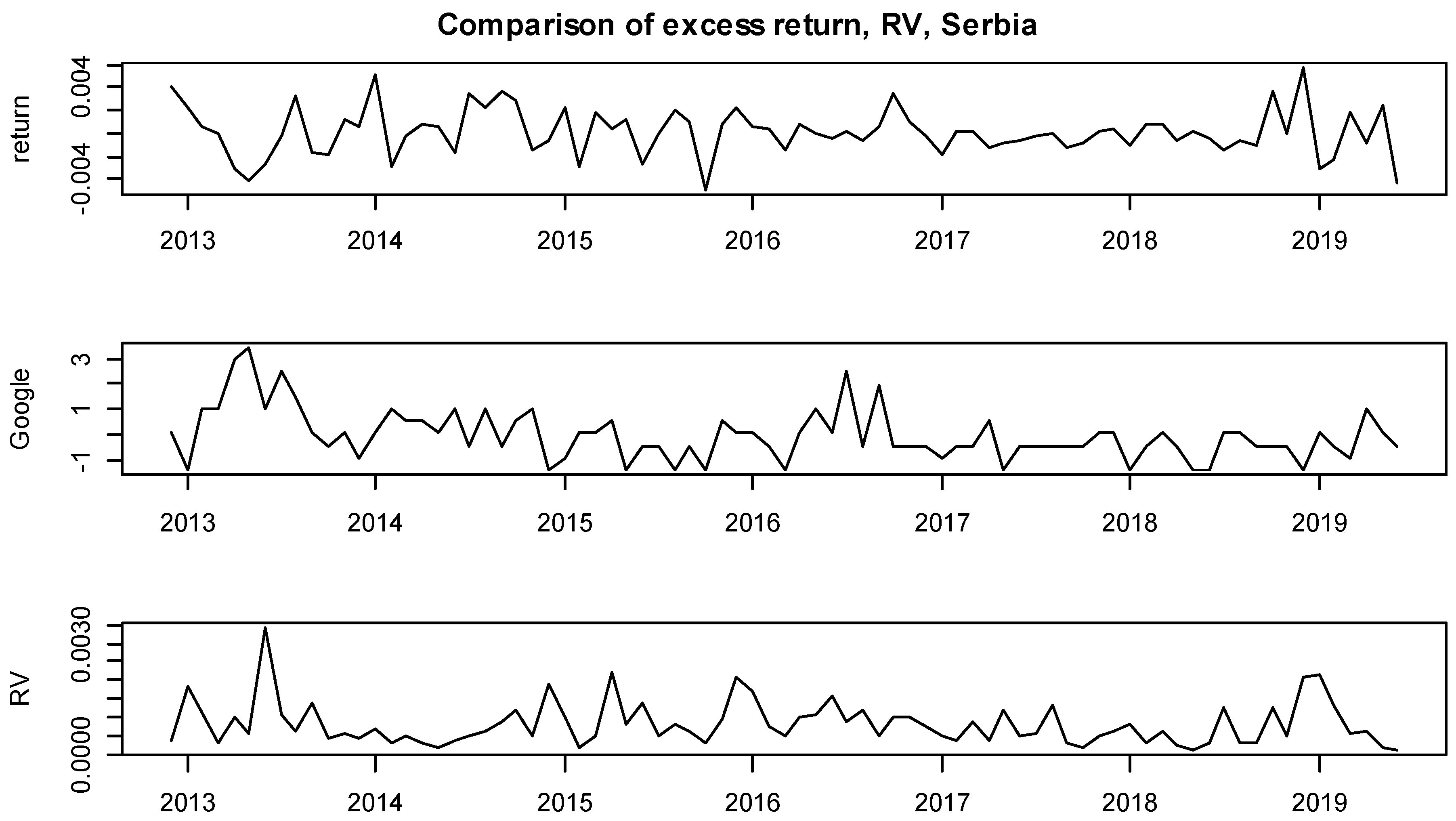
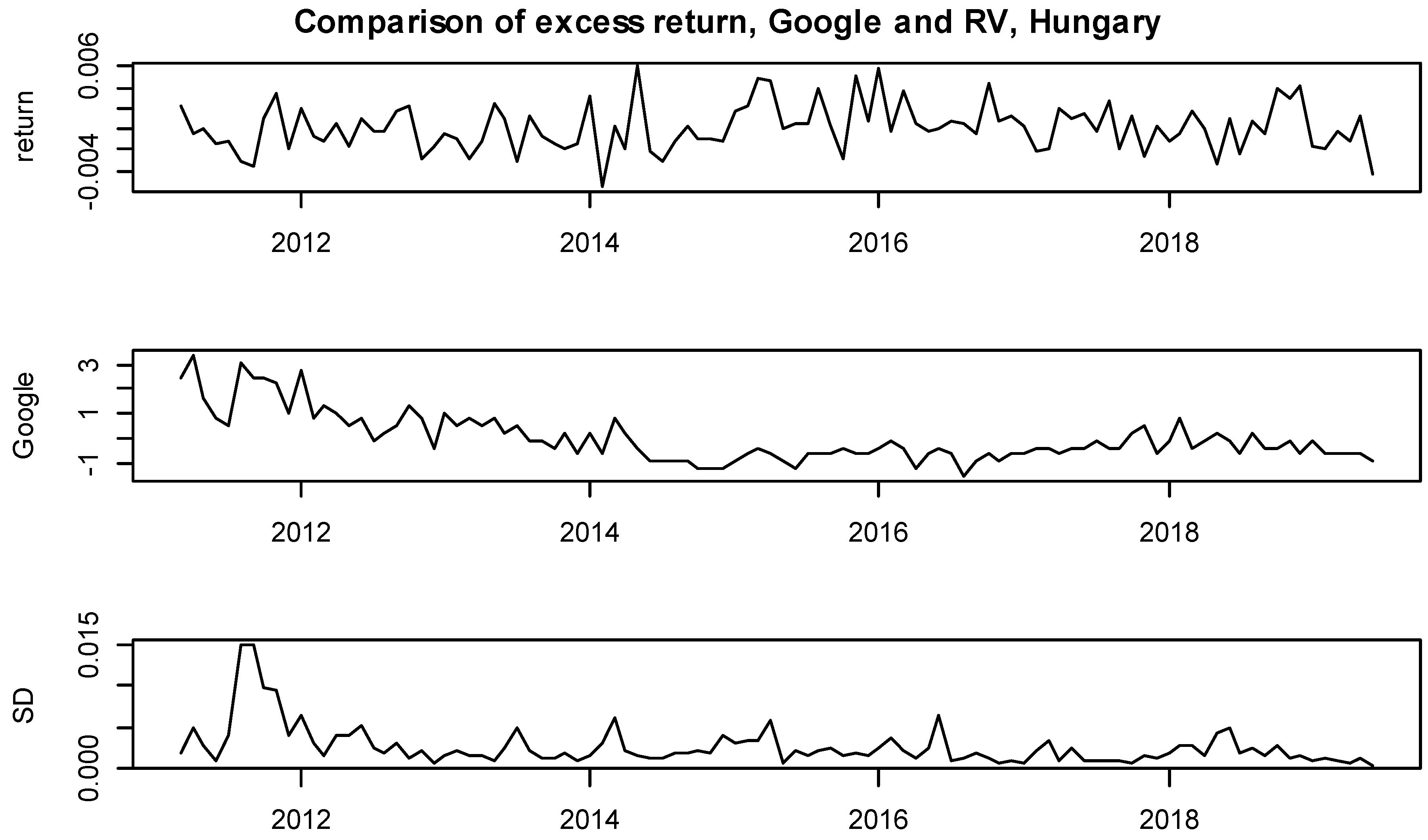
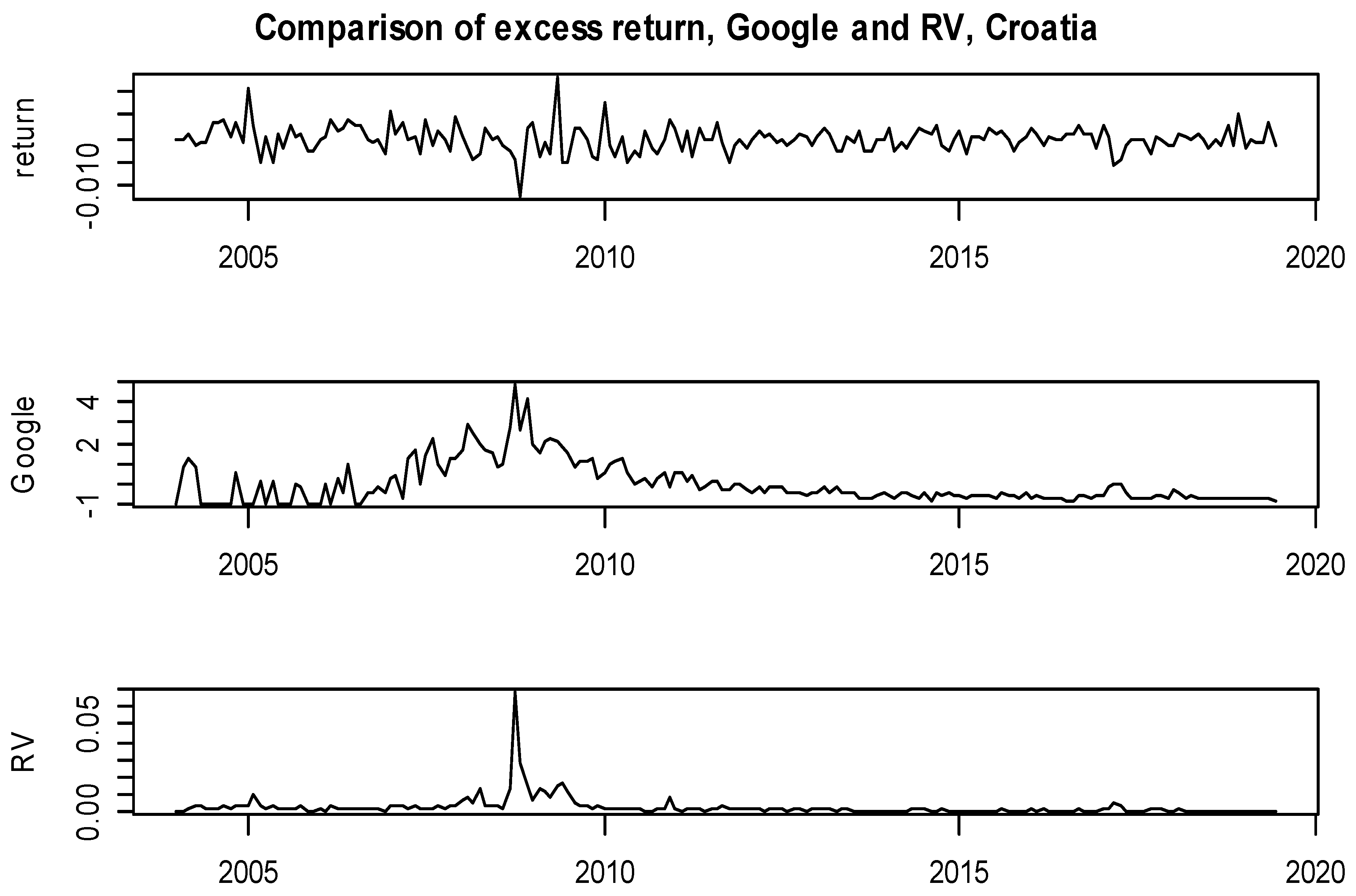

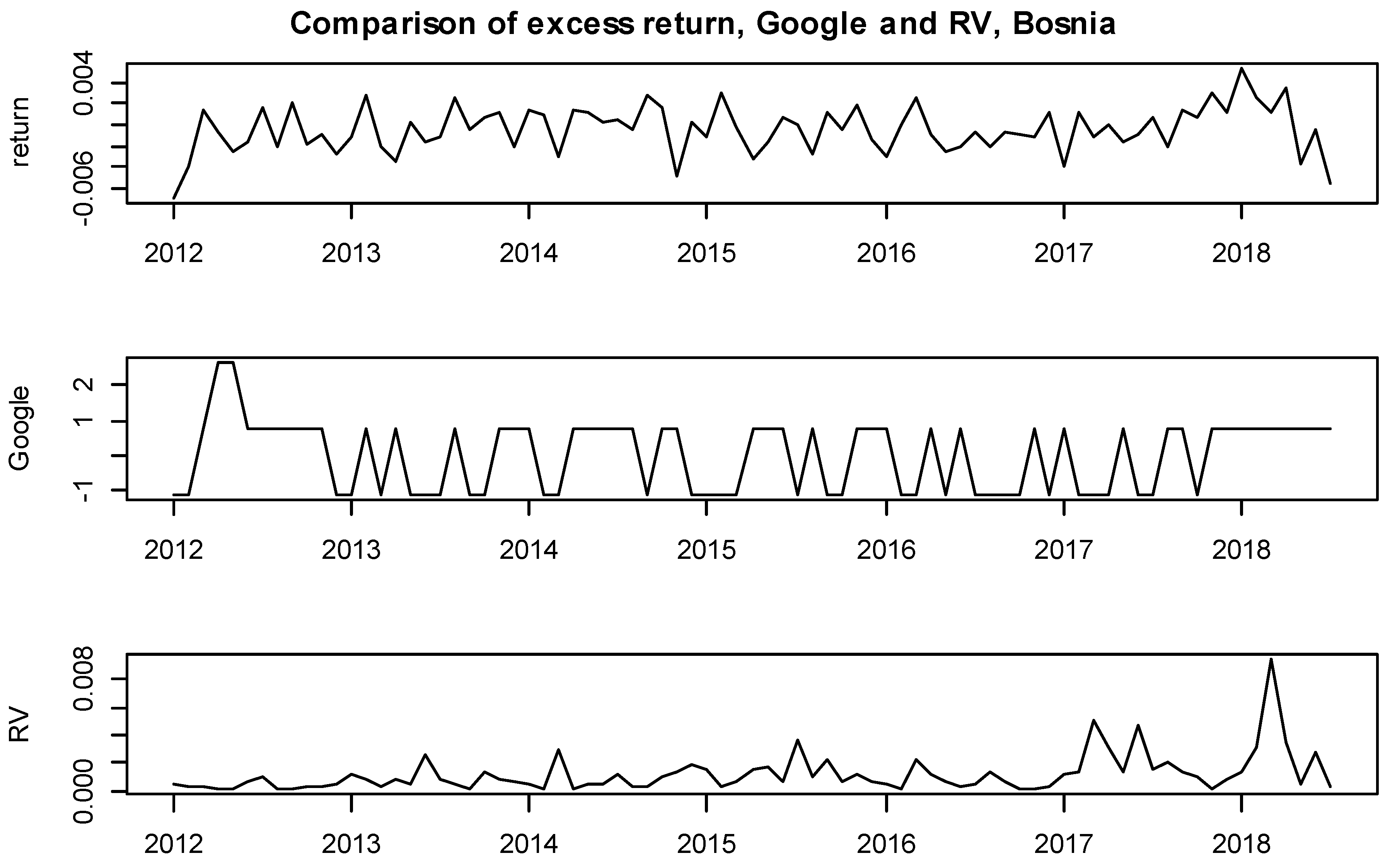

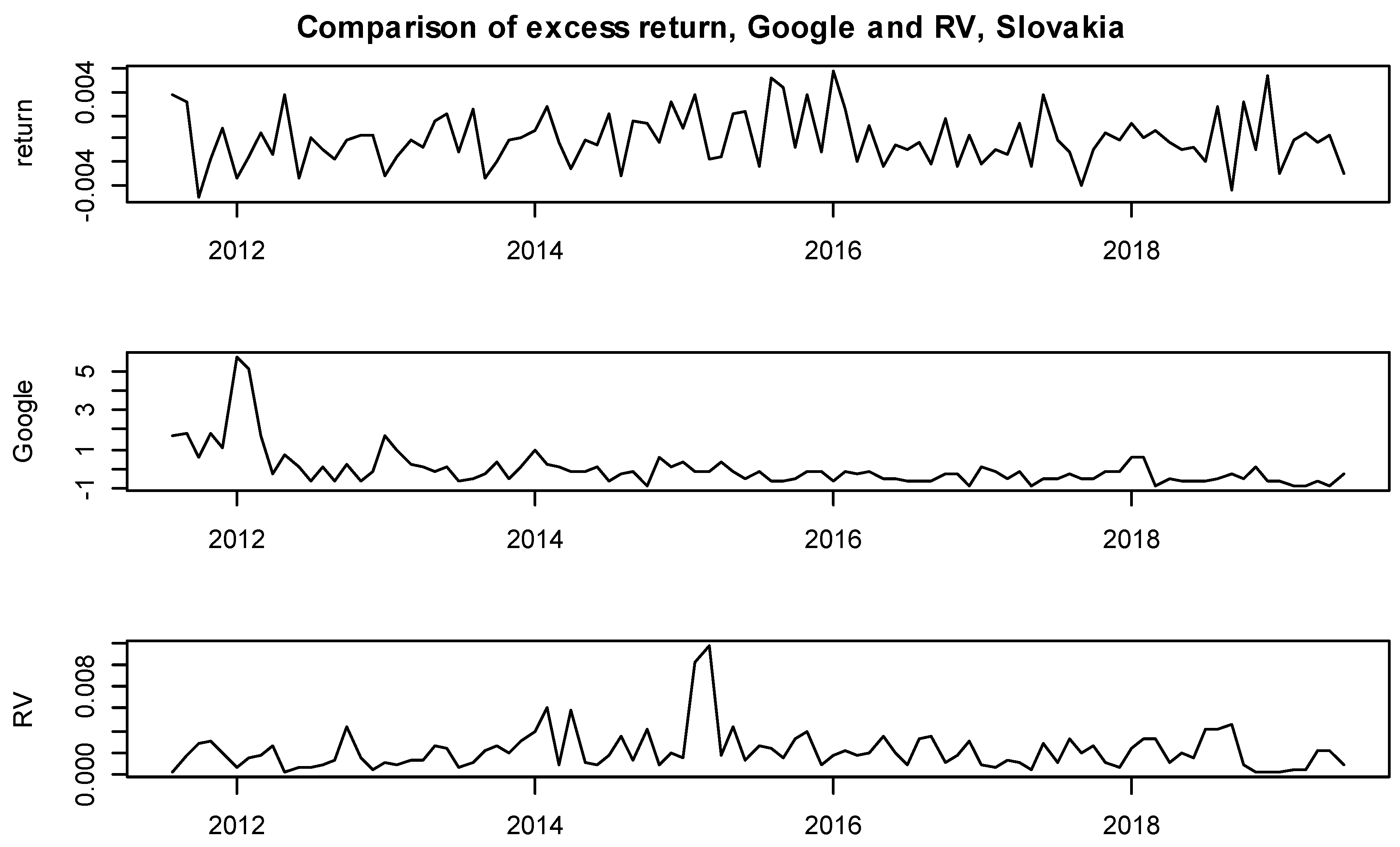
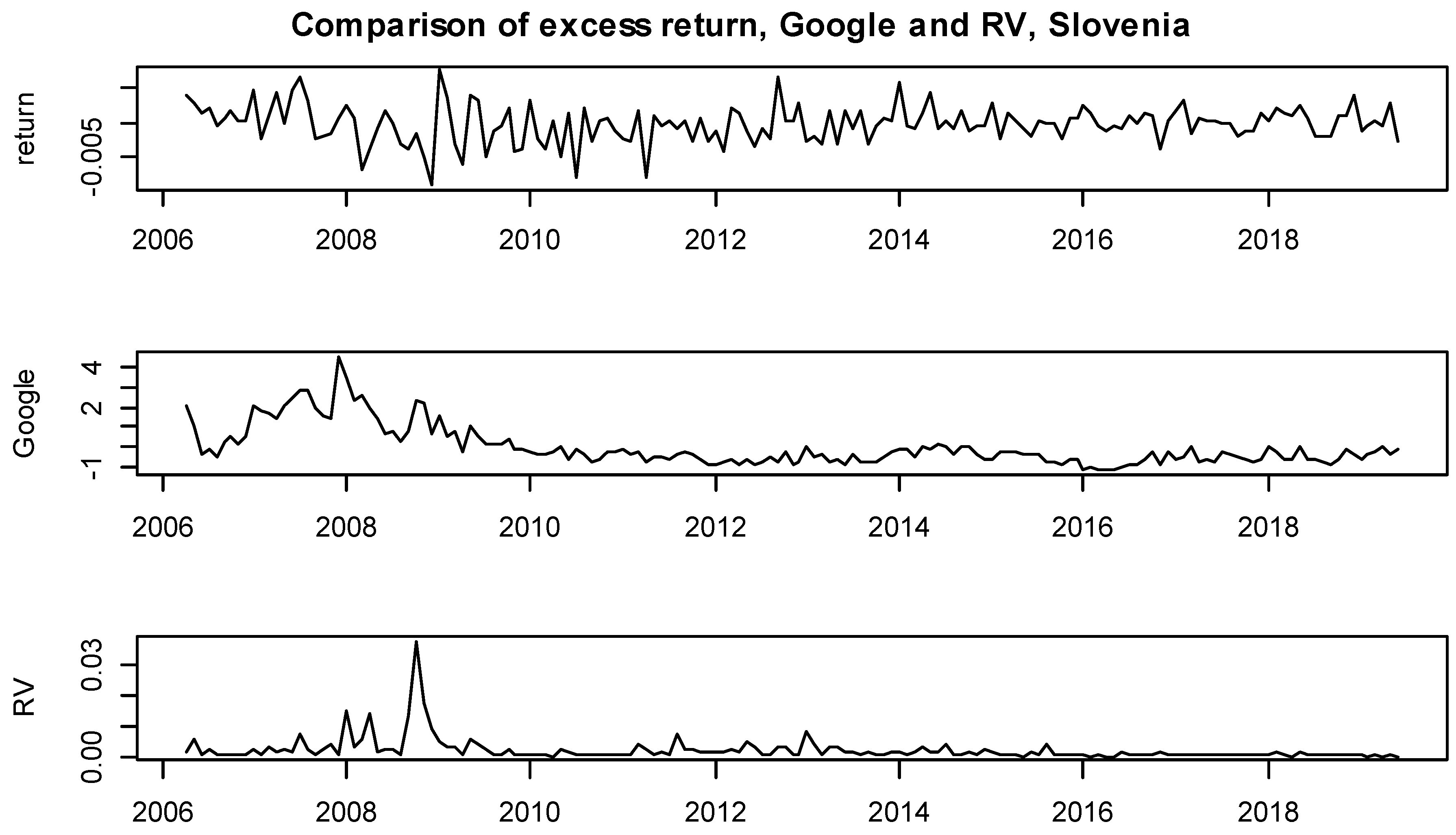
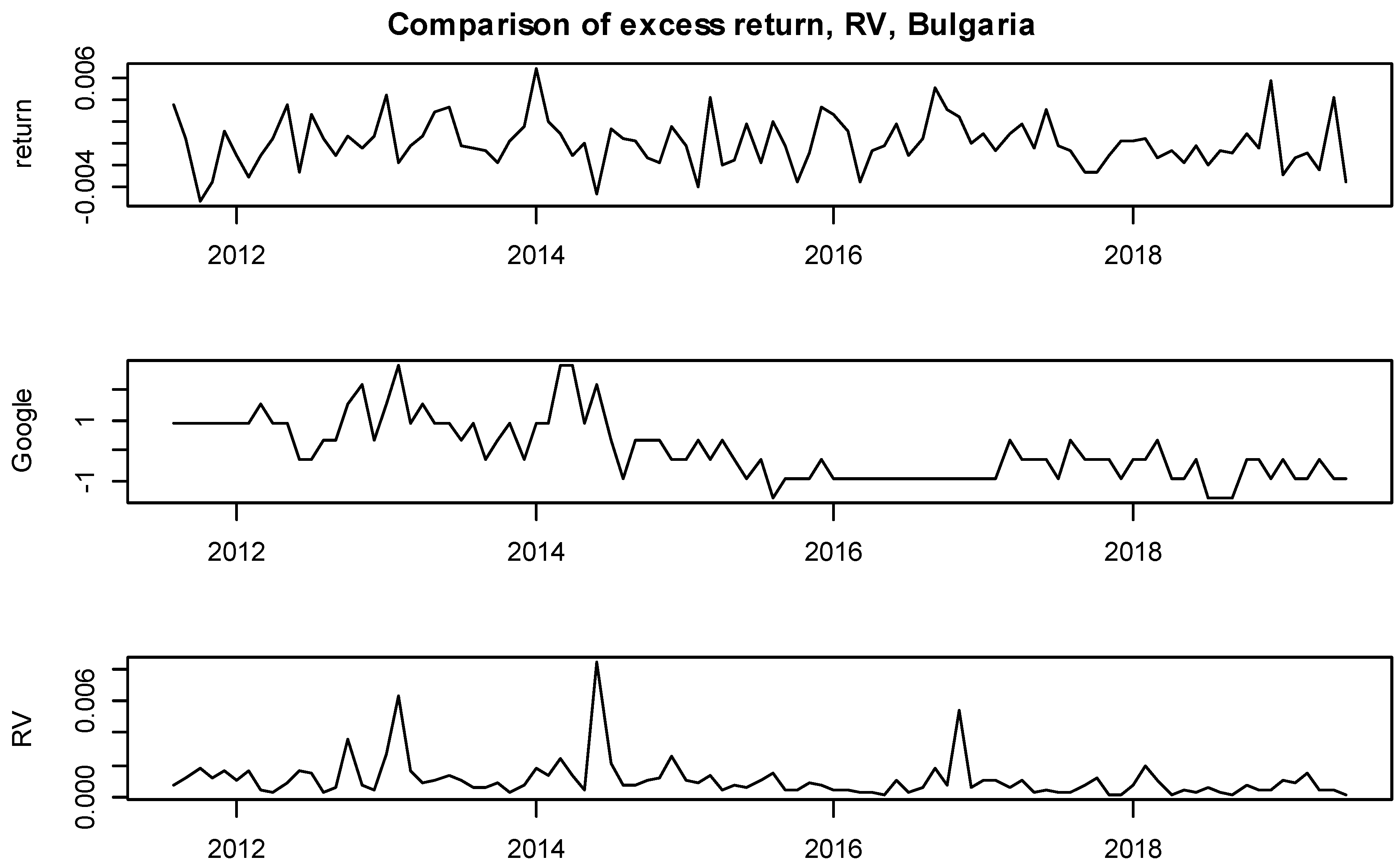
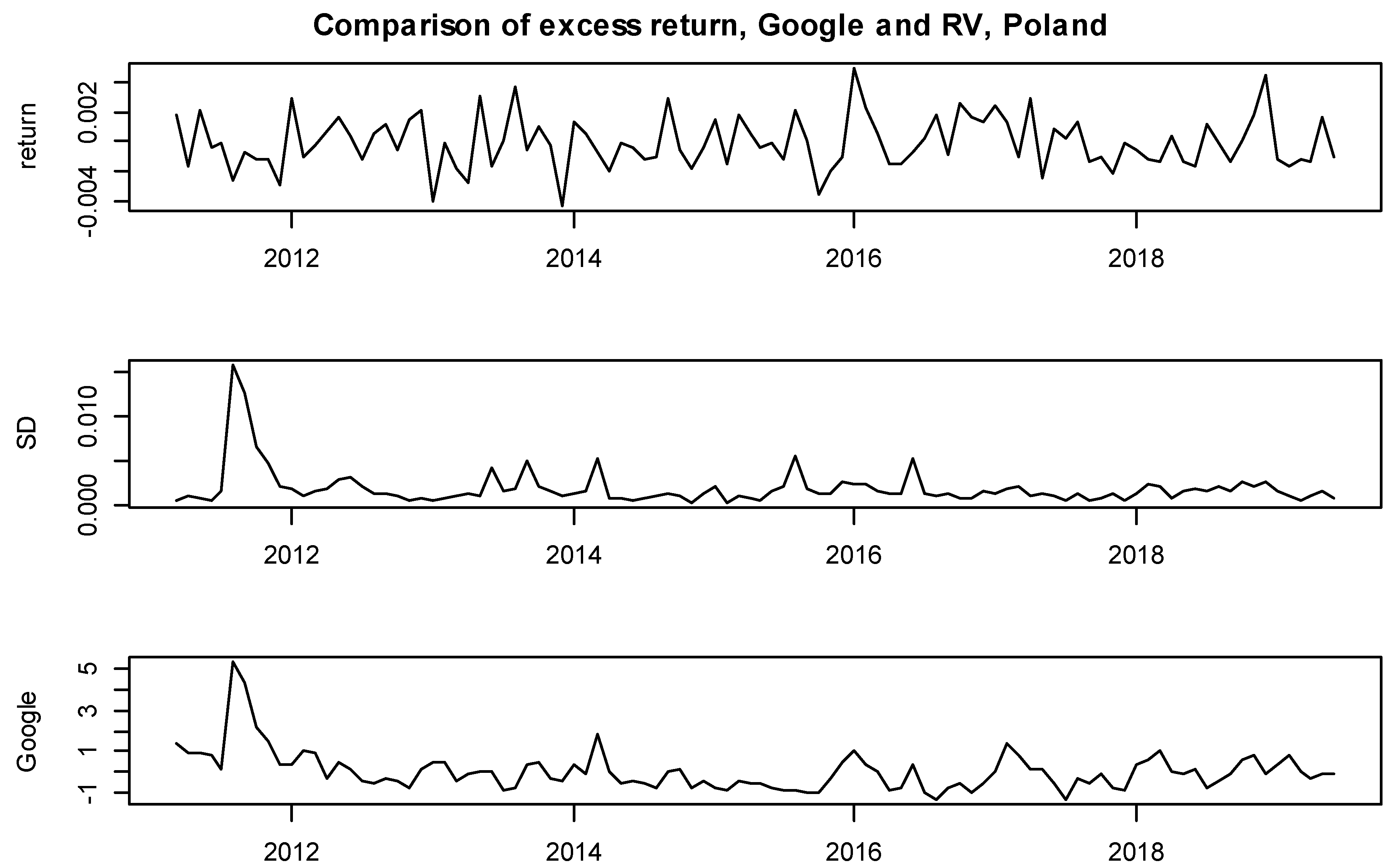
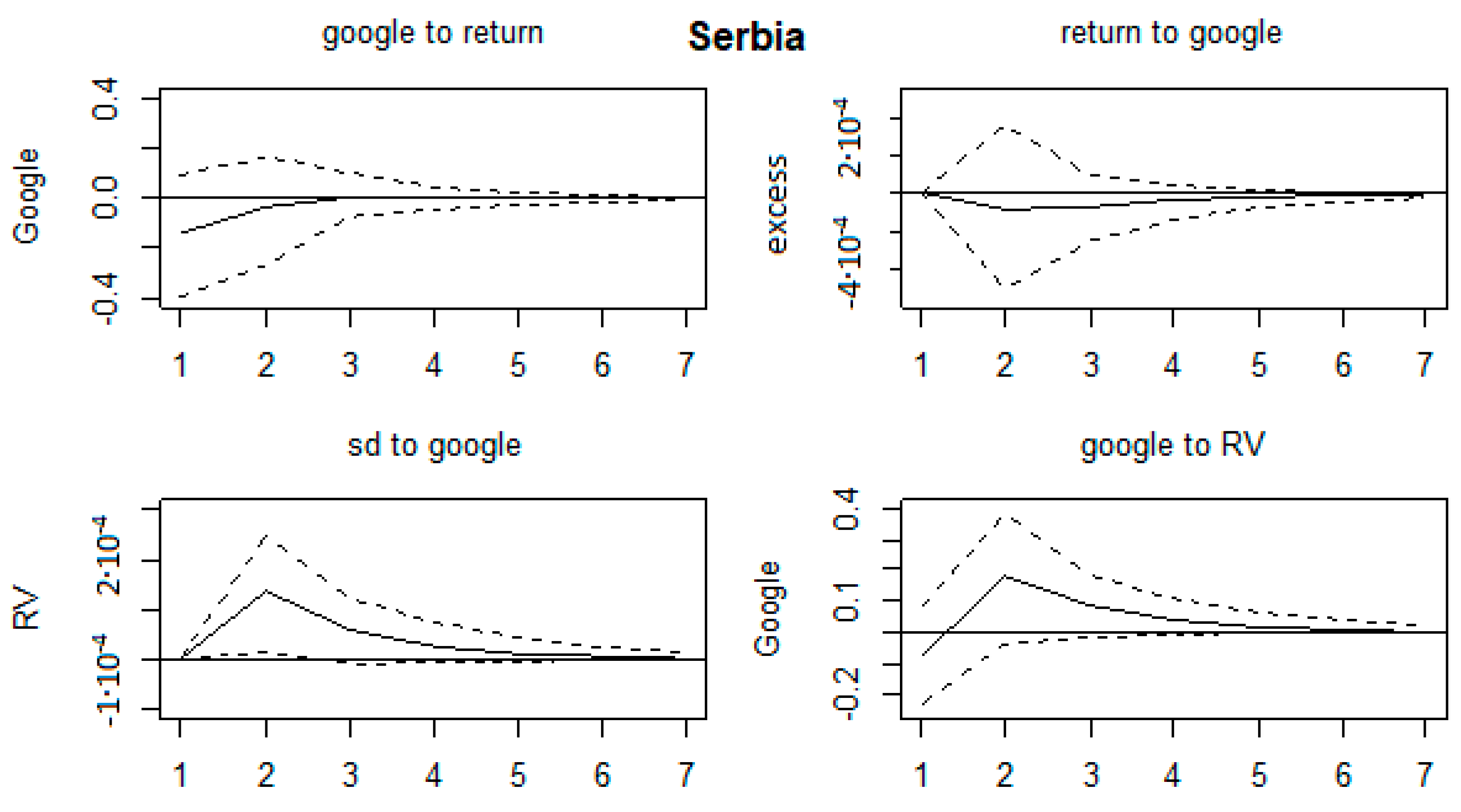
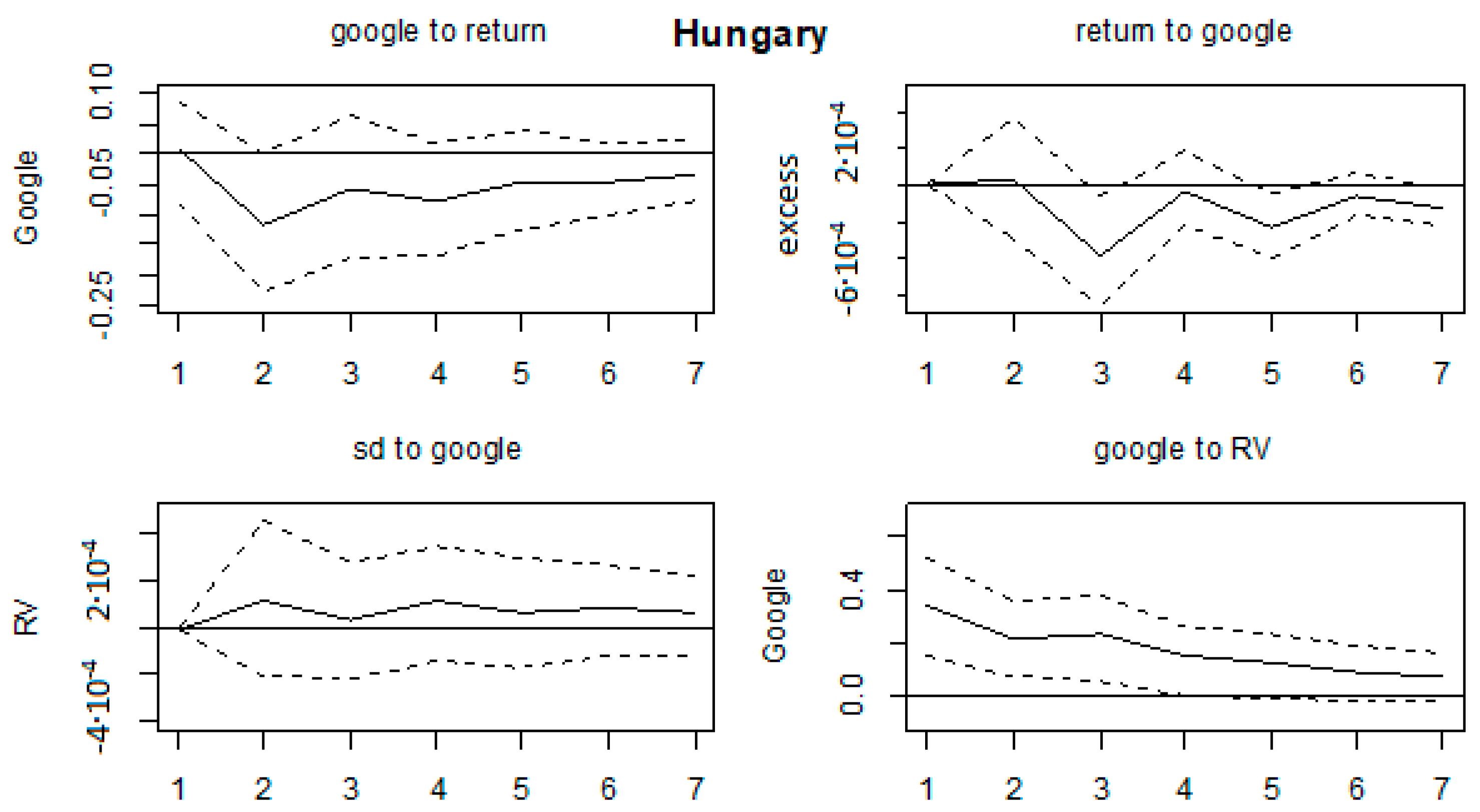
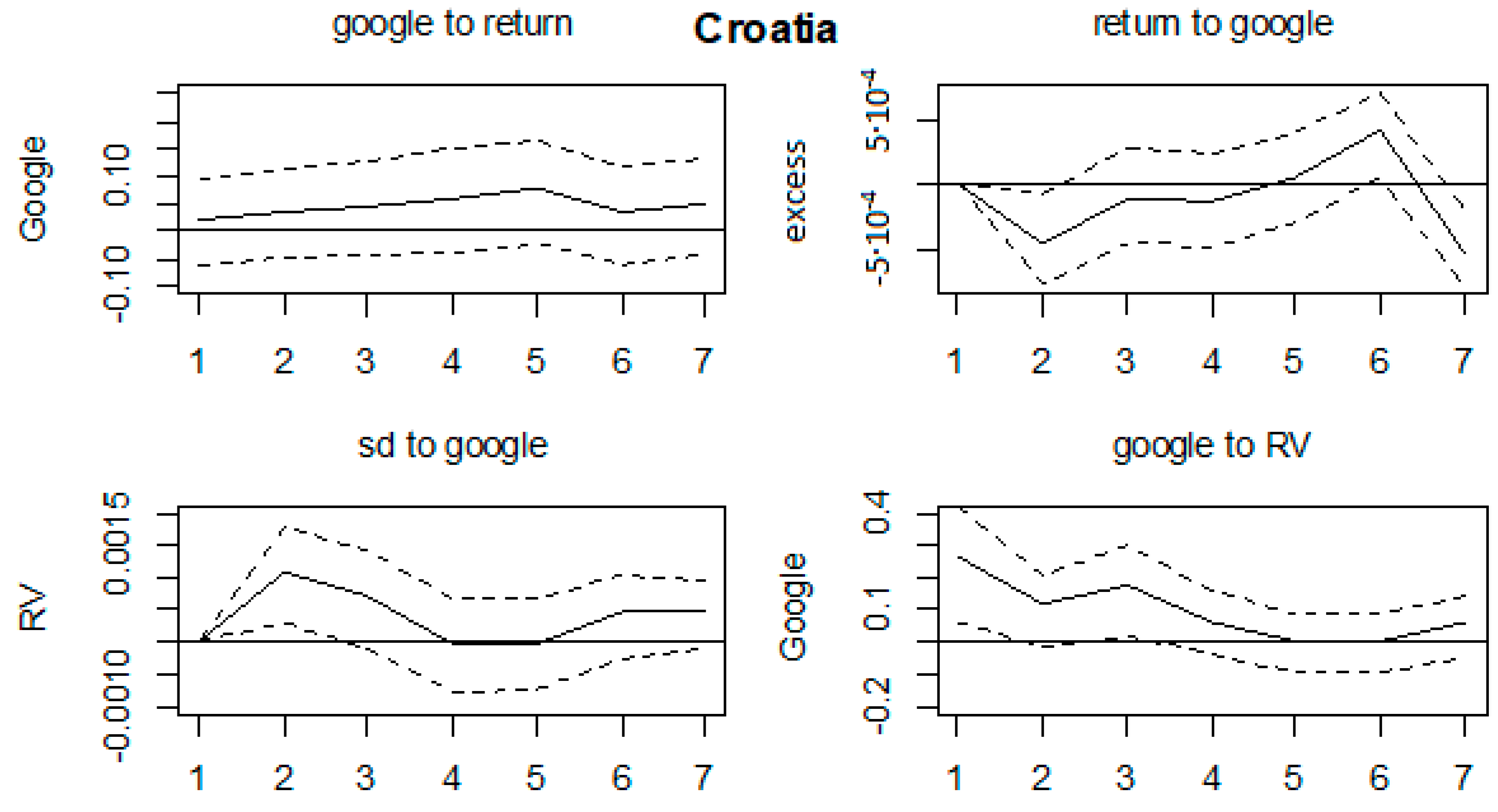
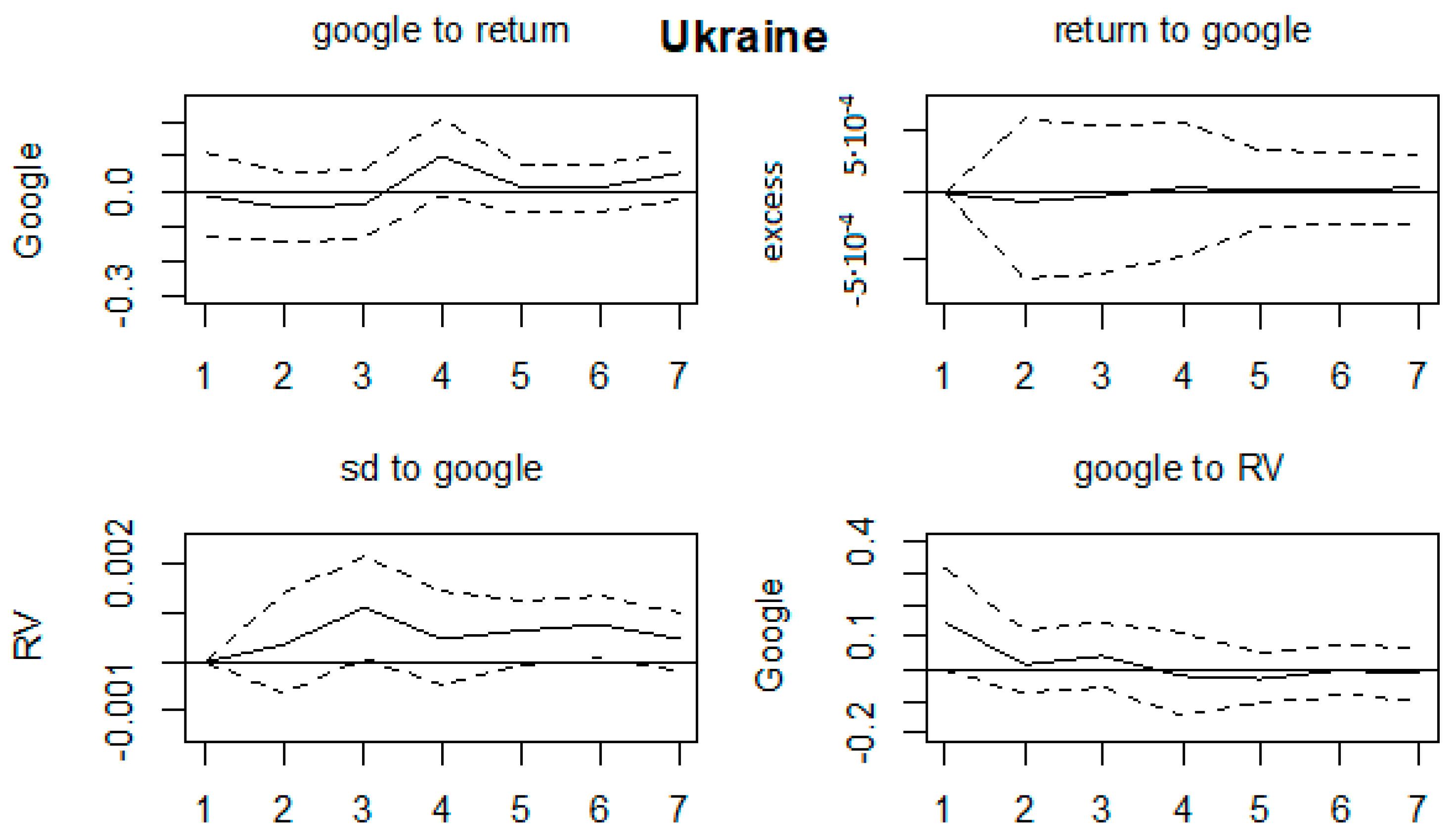
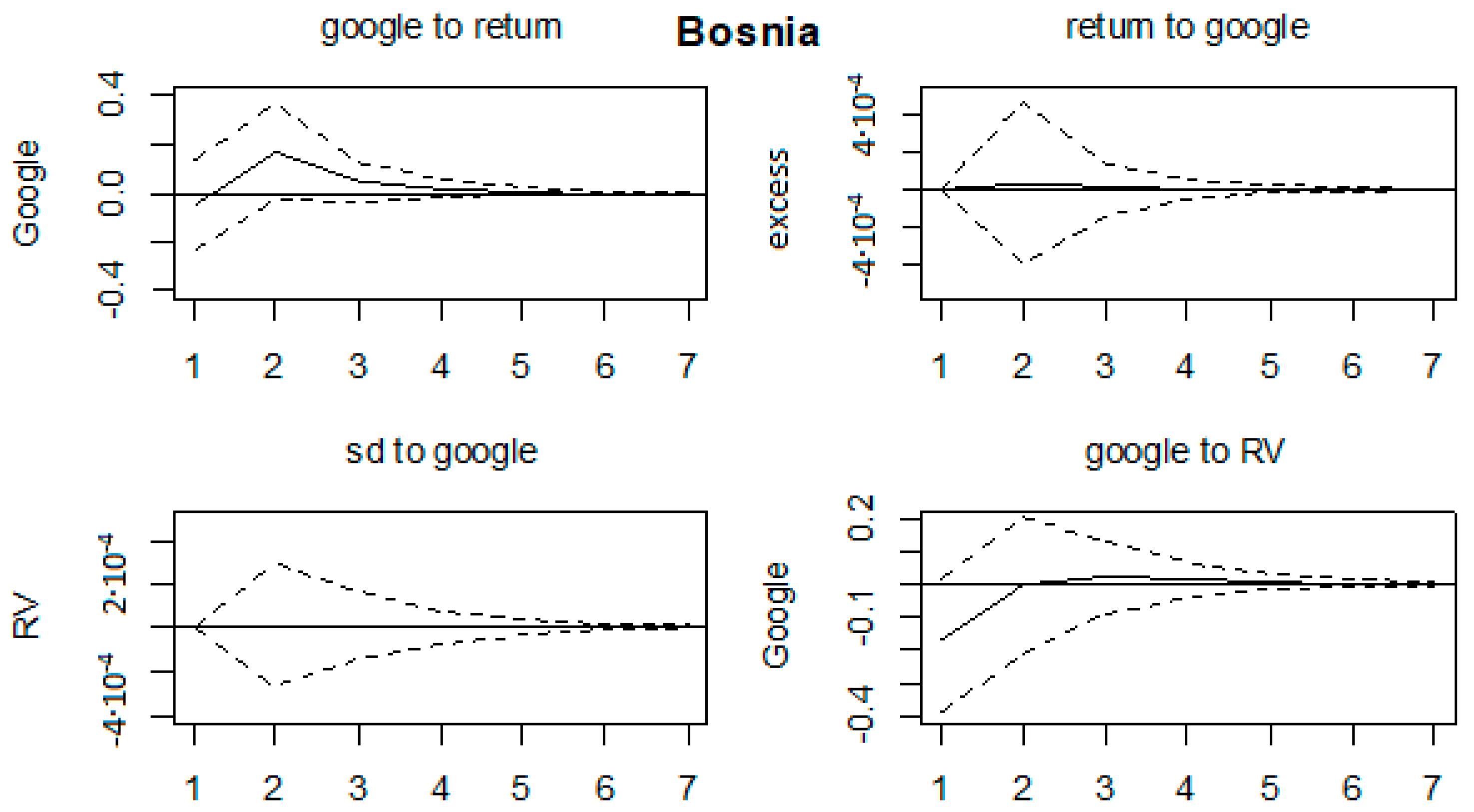
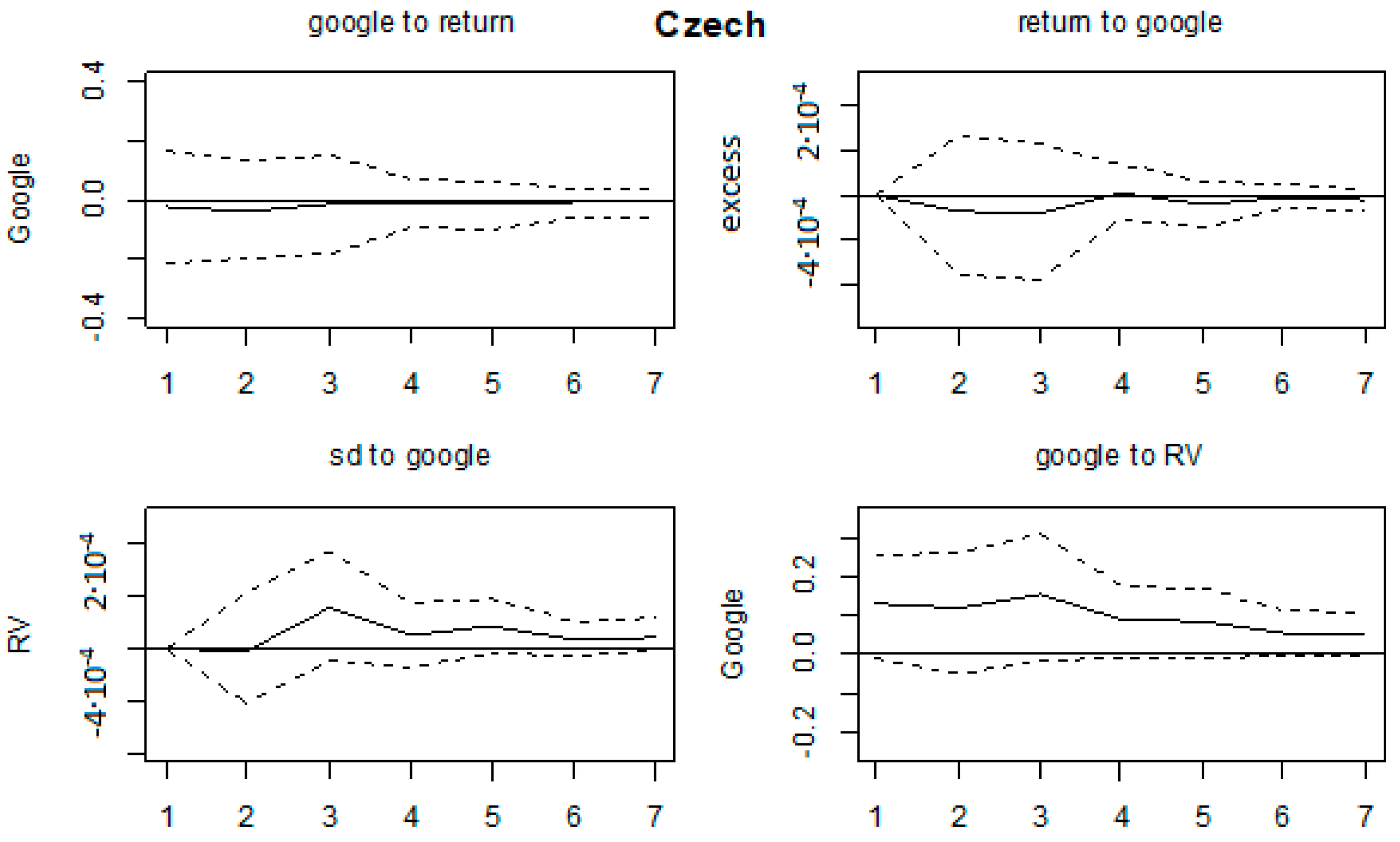


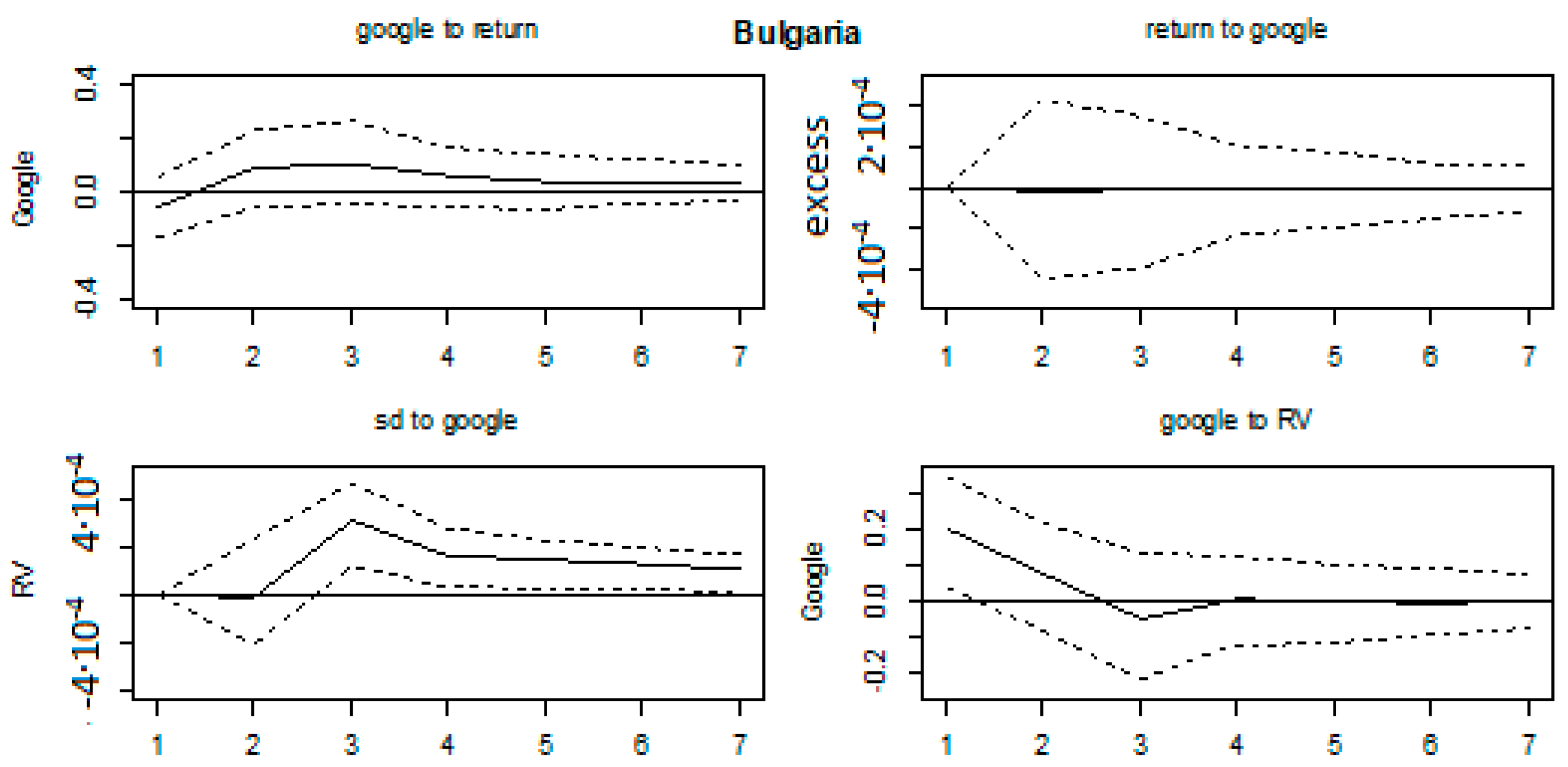
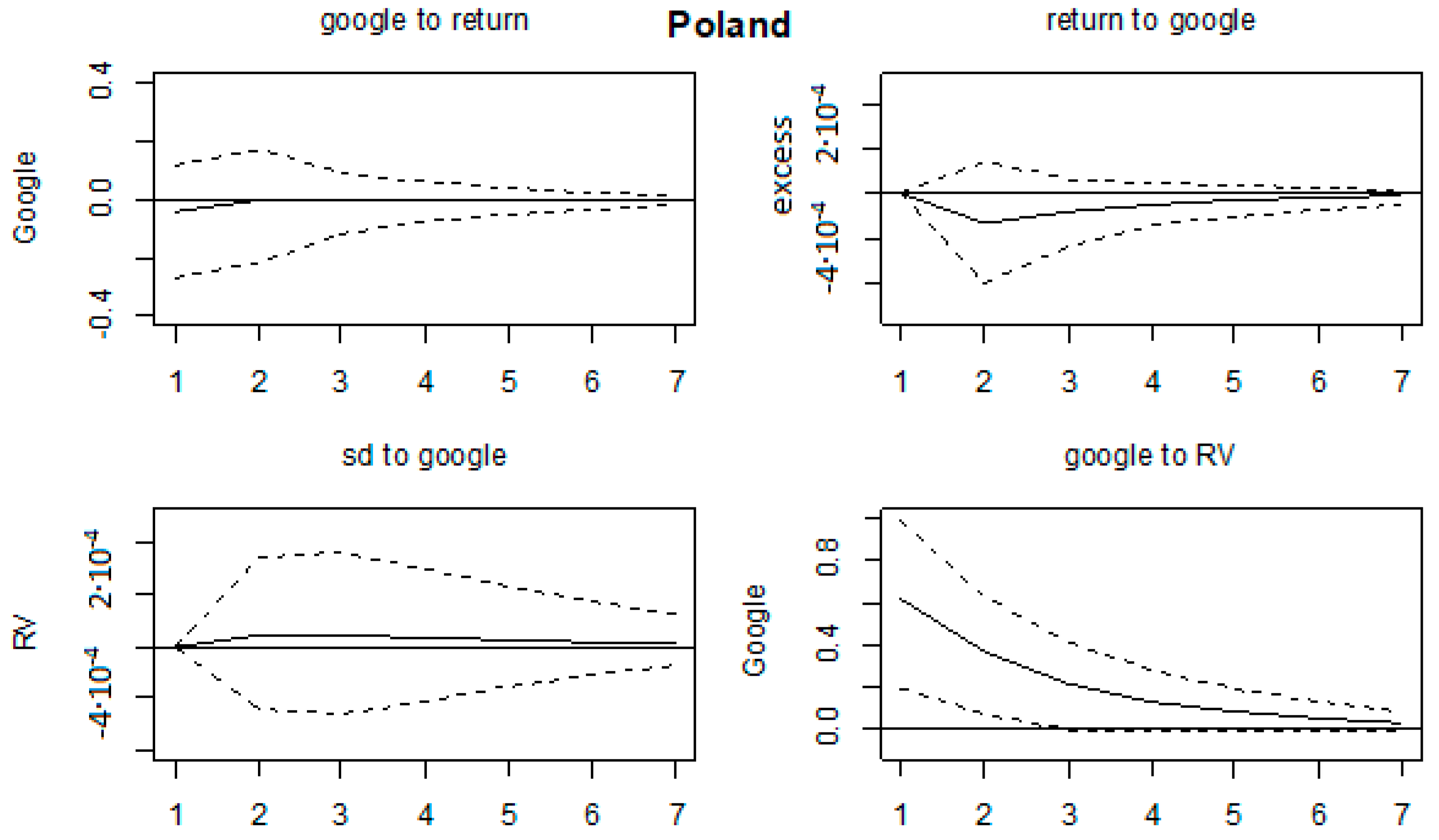
References
- Aalborg, Halvor Aarhus, Peter Molnár, and Jon Erik de Vries. 2019. What can explain the price, volatility and trading volume of Bitcoin? Finance Research Letters 29: 255–65. [Google Scholar] [CrossRef]
- Andersen, Torben, and Tim Bollerslev. 1998. Answering the sceptics: Yes standard volatility models do provide accurate forecasts. International Economic Review 39: 885–905. [Google Scholar] [CrossRef]
- Andrei, Daniel, and Michael Hasler. 2014. Investor attention and stock market volatility. The Review of Financial Studies 28: 33–72. [Google Scholar] [CrossRef]
- Andries, Alin Marius, Iulian Ihnatov, and Nicu Sprincean. 2018. Do seasonal anomalies still exist in central and eastern European countries? A conditional variance approach. Romanian Journal of Economic Forecasting 20: 60–83. [Google Scholar]
- Antonakakais, Nikolas, Cristhophe Andre, and Rangan Gupta. 2016. Dynamic Spillovers in the United States: Stock Market, Housing, Uncertainty, and the Macroeconomy. Southern Economic Journal 83: 609–24. [Google Scholar] [CrossRef]
- Baele, Lieven, Geert Bekaert, and Larissa Schäfer. 2015. An Anatomy of Central and Eastern European Equity Markets. Columbia Business School Working Paper, No. 15–71. Singapore: Columbia Business School. [Google Scholar]
- Bank, Matthias, Martin Larch, and Georg Peter. 2011. Google search volume and its influence on liquidity and returns of German stocks. Financial Markets and Portfolio Management 25: 239–64. [Google Scholar] [CrossRef]
- Barber, Brad, and Terrance Odean. 2007. All that glitters: The effect of attention and news on the buying behavior of individual and institutional investors. Review of Financial Studies 21: 785–818. [Google Scholar] [CrossRef]
- Barndorff-Nielsen, Ole, and Neil Shephard. 2002. Econometric analysis of realised volatility and its use in estimating stochastic volatility models. Journal of the Royal Statistical Society 64: 253–80. [Google Scholar] [CrossRef]
- Bijl, Laurens, Glenn Kringhaug, Peter Molnár, and Eirik Sandvik. 2016. Google searches and stock returns. International Review of Financial Analysis 45: 150–56. [Google Scholar] [CrossRef]
- Black, Fischer. 1986. Noise. The Journal of Finance 41: 529–43. [Google Scholar] [CrossRef]
- Bortoli, Clement, and Stephane Combes. 2015. Contribution from Google Trends for Forecasting the Short-Term Economic Outlook in France: Limited Avenues. Institut National de la Statistique et des Éstudes Économiques. Available online: https://www.insee.fr/en/statistiques/1408911?sommaire=1408916 (accessed on 25 May 2019).
- Chen, Tao. 2017. Investor Attention and Global Stock Returns. Journal of Behavioral Finance 18: 358–72. [Google Scholar] [CrossRef]
- Chen, Joseph, Harrison Hong, and Jeremy Stein. 2002. Breadth of Ownership and Stock Returns. Journal of Financial Economics 66: 171–205. [Google Scholar] [CrossRef]
- Chen, Jian, Guohao Tang, Jiaquan Yao, and Guofu Zhou. 2019. Investor Attention and Stock Returns. Available online: https://ssrn.com/abstract=3194387 (accessed on 25 May 2019).
- Da, Zhi, Joseph Engelberg, and Pngjie Gao. 2010. The Sum of All Fears: Investor Sentiment and Asset Prices, SSRN eLibrary. Available online: https://pdfs.semanticscholar.org/cc4f/6f4dba88381810412ea3d929715f38cb9ee0.pdf (accessed on 25 May 2019).
- Da, Zhi, Joseph Engelberg, and Pengjie Gao. 2011. In search of attention. The Journal of Finance 66: 1461–99. [Google Scholar] [CrossRef]
- De Long Bradford, James, Andrei Shleifer, Lawrence Summers, and Robert Waldmann. 1990. Noise trader risk in financial markets. Journal of Political Economy 98: 703–38. [Google Scholar] [CrossRef]
- Demirer, Mert, Umut Gokcen, and Kamil Yilmaz. 2018. Financial Sector Volatility Connectedness and Equity Returns. Koc University-TUSIAD Economic Research Forum, Working Paper No. 1803. Istanbul: Koc University. [Google Scholar]
- Dergiades, Theologos, Eleni Mavragani, and Bing Pan. 2018. Google trends and tourists’ arrivals: Emerging biases and proposed corrections. Tourism Management 66: 108–20. [Google Scholar] [CrossRef]
- Diebold, Francis, and Kamil Yilmaz. 2009. Measuring Financial Asset Return and Volatility Spillovers with Application to Global Equity Markets. The Economic Journal 119: 158–71. [Google Scholar] [CrossRef]
- Diebold, Francis, and Kamil Yilmaz. 2011. Equity Market Spillovers in the Americas. In Financial Stability, Monetary Policy, and Central Banking. Bank of Chile Central Banking Series 5; Edited by Rodrigo Alfaro. Santiago: Bank of Chile Central Banking, pp. 199–214. [Google Scholar]
- Diebold, Francis, and Kamil Yilmaz. 2012. Better to Give than to Receive: Predictive Directional Measurement of Volatility Spillovers. International Journal of Forecasting 28: 57–66. [Google Scholar] [CrossRef]
- Dimpfl, Thomas, and Stephan Jank. 2016. Can Internet Search Queries Help to Predict Stock Market Volatility? European Financial Management 22: 171–92. [Google Scholar] [CrossRef]
- Dzielinski, Michal. 2012. Measuring economic uncertainty and its impact on the stock market. Finance Research Letters 9: 167–75. [Google Scholar] [CrossRef]
- Fama, Eugene. 1965. Random Walks in Stock Market Prices. Financial Analysts Journal 21: 55–59. [Google Scholar] [CrossRef] [Green Version]
- Fama, Eugene. 1970. Efficient Capital Markets: A Review of Theory and Empirical Work. The Journal of Finance 25: 383–417. [Google Scholar] [CrossRef]
- Fang, Lily, and Joel Peress. 2009. Media Coverage and the Cross-section of Stock Returns. The Journal of Finance 64: 2023–52. [Google Scholar] [CrossRef]
- Ferreira, Paulo. 2018. Long-range dependencies of Eastern European stock markets: A dynamic detrended analysis. Physica A 505: 454–70. [Google Scholar] [CrossRef]
- Frieder, Laura, and Avanidhar Subrahmanyam. 2005. Brand Perceptions and the Market for Common Stock. Journal of Financial and Quantitative Analysis 40: 57–85. [Google Scholar] [CrossRef]
- Goddard, John, Arben Kita, and Qingwei Wang. 2015. Investor attention and FX market volatility. Journal of International Financial Markets, Institutions & Money 38: 79–96. [Google Scholar] [Green Version]
- Goel, Sharad, Jake Hofman, Sebastien Lahaie, David Pennock, and Duncan Watts. 2010. Predicting consumer behavior with Web search. Proceedings of the National Academy of Sciences of the United States of America 107: 17486–90. [Google Scholar] [CrossRef]
- Google Trends Data. 2019. Available online: https://trends.google.com/trends/ (accessed on 25 May 2019).
- Grinblatt, Mark, and Matti Keloharju. 2000. The investment behavior and performance of various investor types: A study of Finland’s unique data set. Journal of Financial Economics 55: 43–67. [Google Scholar] [CrossRef]
- Grullon, Gustavo, George Kanatas, and James Weston. 2004. Advertising, breadth of ownership, and liquidity. Review of Financial Studies 17: 439–61. [Google Scholar] [CrossRef]
- Habibah, Ume, Suresh Rajput, and Ranjeta Sadhwani. 2017. Stock market return predictability: Google pessimistic sentiments versus fear gauge. Cogent Economics & Finance 5: 1390897. [Google Scholar]
- Hamid, Alain, and Moritz Heiden. 2015. Forecasting volatility with empirical similarity and Google Trends. Journal of Economic Behavior & Organization 117: 62–81. [Google Scholar]
- Han, Liyan, Ziying Li, and Libo Yin. 2017. Investor Attention and Stock Returns: International Evidence. Emerging Markets Finance and Trade 54: 3168–88. [Google Scholar] [CrossRef]
- Havranek, Tomas, and Ayaz Zeynalov. 2018. Forecasting Tourist Arrivals: Google Trends Meets Mixed Frequency Data. Munich Personal RePEc Archive, MPRA paper No. 90203. Munich: Munich University Library. [Google Scholar]
- Investing Data Website. 2019. Available online: https://www.investing.com/ (accessed on 25 May 2019).
- Joseph, Kissain, Babajide Wintoki, and Zelin Zhang. 2011. Forecasting abnormal stock returns and trading volume using investor sentiment: Evidence from online search. International Journal of Forecasting 27: 1116–27. [Google Scholar] [CrossRef]
- Jun, Seung-Pyo, Hyoung Sun Yoo, and San Choi. 2018. Ten years of research change using Google Trends: From the perspective of big data utilizations and applications. Technological Forecasting & Social Change 130: 69–87. [Google Scholar]
- Khan, Mehwish Aziz, and Eatzaz Ahmad. 2018. Measurement of Investor Sentiment and Its Bi-Directional Contemporaneous and Lead–Lag Relationship with Returns: Evidence from Pakistan. Sustainability 11: 94. [Google Scholar] [CrossRef]
- Kim, Neri, Katarína Lučivjanská, Peter Molnár, and Roviel Villa. 2019. Google searches and stock market activity: Evidence from Norway. Finance Research Letters 28: 208–20. [Google Scholar] [CrossRef]
- Koop, Gary, Mashem Pesaran, and Simon Potter. 1996. Impulse response analysis in nonlinear multivariate models. Journal of Econometrics 74: 119–47. [Google Scholar] [CrossRef]
- Lehavy, Reuven, and Richard Sloan. 2008. Investor recognition and stock returns. Review of Accounting Studies 13: 327–61. [Google Scholar] [CrossRef]
- Li, Jun, and Jiangfeng Yu. 2012. Investor Attention, Psychological Anchors, and Stock Return Predictability. Journal of Financial Economics 104: 401–19. [Google Scholar] [CrossRef]
- Lütkepohl, Helmut. 1993. Introduction to Multiple Time Series Analysis. Berlin: Springer. [Google Scholar]
- Lütkepohl, Helmut. 2006. New Introduction to Multiple Time Series Analysis. Berlin: Springer. [Google Scholar]
- Lütkepohl, Helmut. 2010. Vector Autoregressive Models. Economics Working Paper ECO 2011/30. Fiesole: European University Institute. [Google Scholar]
- Merton, Robert. 1987. A simple model of capital market equilibrium with incomplete information. The Journal of Finance 42: 483–510. [Google Scholar] [CrossRef]
- Molnár, Peter, and Milan Bašta. 2017. Google searches and Gasoline prices. Paper presented at 2017 14th International Conference on the European Energy Market (EEM), Dresden, Germany, June 6–9; pp. 1–5. [Google Scholar]
- Mondria, Jordi, Thomas Wu, and Yi Zhang. 2010. The determinants of international investment and attention allocation: Using internet search query data. Journal of International Economics 82: 85–95. [Google Scholar] [CrossRef] [Green Version]
- Necula, Ciprian, and Alina-Nicoleta Radu. 2012. Long Memory in Eastern European Financial Markets Returns. Economic Research 25: 316–77. [Google Scholar] [CrossRef]
- Netmarketshare. 2019. Available online: https://netmarketshare.com (accessed on 25 May 2019).
- Odean, Terrance. 1998. Are investors reluctant to realize their losses? The Journal of Finance 53: 1775–98. [Google Scholar] [CrossRef]
- Önder, Irem. 2017. Forecasting tourism demand with Google trends: Accuracy comparison of countries versus cities. International Journal of Tourism Research 19: 648–660. [Google Scholar] [CrossRef]
- Padungsaksawasdi, Chaiyuth, Sirimon Treepongkaruna, and Robert Brooks. 2019. Investor Attention and Stock Market Activities: New Evidence from Panel Data. International Journal of Financial Studies 7: 30. [Google Scholar] [CrossRef]
- Peng, Lin, and Wei Xiong. 2006. Investor attention, overconfidence and category learning. Journal of Financial Economics 80: 563–602. [Google Scholar] [CrossRef] [Green Version]
- Pesaran, Hashem, and Yongcheol Shin. 1998. Generalized impulse response analysis in linear multivariate models. Economics Letters 58: 17–29. [Google Scholar] [CrossRef]
- Preis, Tobias, Daniel Reith, and Eugene Stanley. 2010. Complex dynamics of our economic life on different scales: Insights from search engine query data. Philosophical Transactions of the Royal Society A 368: 5707–19. [Google Scholar] [CrossRef]
- Preis, Tobias, Helen Susannah Moat, and Eugene Stanley. 2013. Quantifying Trading Behavior in Financial Markets Using Google Trends. Scientific Reports 3: 1684. [Google Scholar] [CrossRef]
- Sibley, Steven, Yanchu Wang, Yuhang Xing, and Xiaoyan Zhang. 2016. The information content of the sentiment index. Journal of Banking & Finance 62: 164–79. [Google Scholar]
- Škrinjarić, Tihana. 2018a. Mogu li Google trend podaci poboljšati prognoziranje prinosa na Zagrebačkoj burzi? (Can Google trend data enhance return forecasting on Zagreb Stock Exchange?). Zbornik radova Ekonomskog fakulteta Sveučilišta u Mostaru (Journal of Economy and Business, University of Mostar) 24: 58–76. [Google Scholar]
- Škrinjarić, Tihana. 2018b. The value of food sector on Croatian capital market if the Agrokor crisis did not happen: Synthetic control method approach. CEA Journal of Economics 13: 53–65. [Google Scholar]
- Škrinjarić, Tihana. 2018c. Testing for Seasonal Affective Disorder on Selected CEE and SEE Stock Markets. Risks 6: 140. [Google Scholar] [CrossRef]
- Škrinjarić, Tihana, and Mirjana Čižmešija. 2019. Investor attention and risk predictability: A spillover index approach. Paper presented at the 15th International Symposium on Operations Research in Slovenia, Bled, Slovenia, September 25–27; pp. 423–28. [Google Scholar]
- Škrinjarić, Tihana, and Zrinka Orlović. 2019. Effects of economic and political events on stock returns: Event study of Agrokor case in Croatia. Croatian Economic Survey 21: 47–86. [Google Scholar] [CrossRef]
- Smith, Geoffrey Peter. 2012. Google Internet Search Activity and Volatility Prediction in the Market for Foreign Currency. Finance Research Letters 9: 103–10. [Google Scholar] [CrossRef]
- Takeda, Fumika, and Takumi Wakao. 2014. Google search intensity and its relationship with returns and trading volume of Japanese stocks. Pacific-Basin Finance Journal 27: 1–18. [Google Scholar] [CrossRef]
- Tan, Selin Düz, and Oktay Tas. 2019. Investor attention and stock returns: Evidence from Borsa Istanbul. Borsa Istanbul Review 19: 106–16. [Google Scholar]
- Tantaopas, Parkpoom, Chaiyuth Padungsaksawasdi, and Sirimon Treepongkaruna. 2016. Attention effect via internet search intensity in Asia-Pacific stock markets. Pacific-Basin Finance Journal 38: 107–24. [Google Scholar] [CrossRef]
- Tkacz, Greg. 2013. Predicting Recessions in Real-Time: Mining Google Trends and Electronic Payments Data for Clues. C.D. Howe Institute, Issue 387. Toronto: C. D. Howe Institute Commentary. [Google Scholar]
- Urbina, Jilber. 2013. Financial Spillovers across Countries: Measuring Shock Transmissions. MPRA Working Paper. Munich: Munich Personal RePEc Archive. [Google Scholar]
- Vlastakis, Nikolas, and Raphael Markellos. 2012. Information demand and stock market volatility. Journal of Banking & Finance 36: 1808–21. [Google Scholar]
- Vosen, Simeon, and Torsten Schmidt. 2011. Forecasting Private Consumption: Survey Based Indicators vs. Google Trends. Journal of Forecasting 30: 565–78. [Google Scholar] [CrossRef]
- Vozlyublennaia, Nadia. 2014. Investor attention, index performance, and return predictability. Journal of Banking & Finance 41: 17–35. [Google Scholar]
- Woo, Jaemin, and Ann Owen. 2019. Forecasting private consumption with Google Trends data. Journal of Forecasting 38: 81–89. [Google Scholar] [CrossRef]
- Yang, Tian, Jinsong Liu, Qianwei Ying, and Tahir Yousaf. 2019. Media Coverage and Sustainable Stock Returns: Evidence from China. Sustainability 11: 2335. [Google Scholar] [CrossRef]
- Zhang Wei, Dehua Shen, Yongjie Zhang, and Xiong Xiong. 2013. Open source information, investor attention, and asset pricing. Economic Modelling 33: 613–619. [Google Scholar] [CrossRef]
- Zhang, Junru, Hadrian Geri Djajadikerta, and Zhaoyong Zhang. 2018. Does Sustainability Engagement Affect Stock Return Volatility? Evidence from the Chinese Financial Market. Sustainability 10: 3361. [Google Scholar] [CrossRef]
| 1 | For details, please see Lehavy and Sloan (2008). |
| 2 | Autoregressive integrated moving average—generalized autoregressive conditional heteroskedasticity. |
| 3 | Vector auto regression. |
| 4 | Individual company names are utilized in studies, which observe those company returns series, as in Preis et al. (2010); Bijl et al. (2016); Tan and Tas (2019) and Khan and Ahmad (2018). |
| 5 | Authors observed Romania, Hungary, Czech Republic, Poland, Slovenia, Bulgaria, Slovakia and Croatia and found inefficiencies of the stock markets by using the fractional differencing approach. |
| 6 | Authors compared CEE stock markets by using a variety of measures regarding growth, development, concentration, etc. Although these countries faced a similar past regarding the economic system, their stock markets today have somewhat great differences in terms of market concentration, liquidity, etc. |
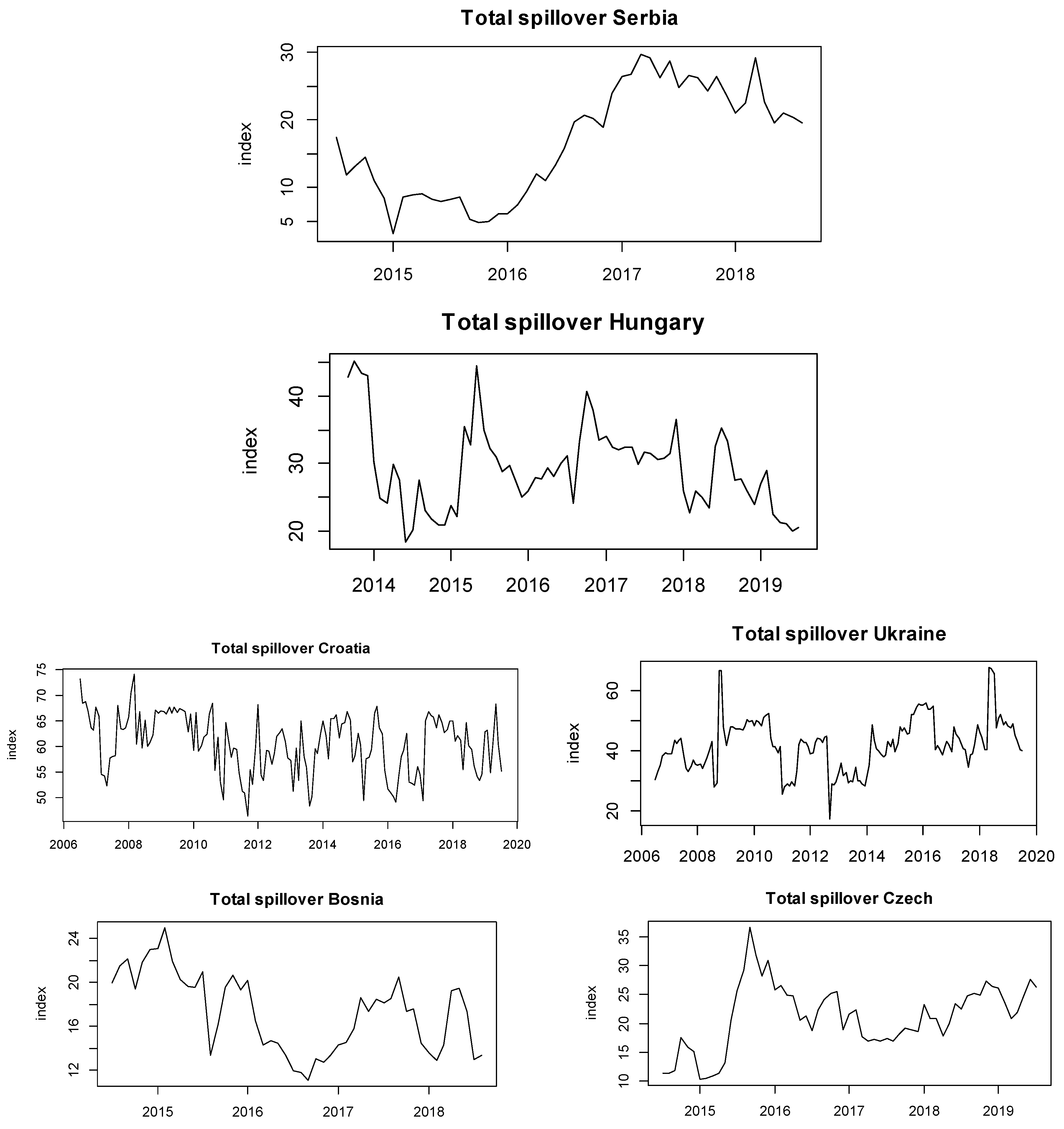
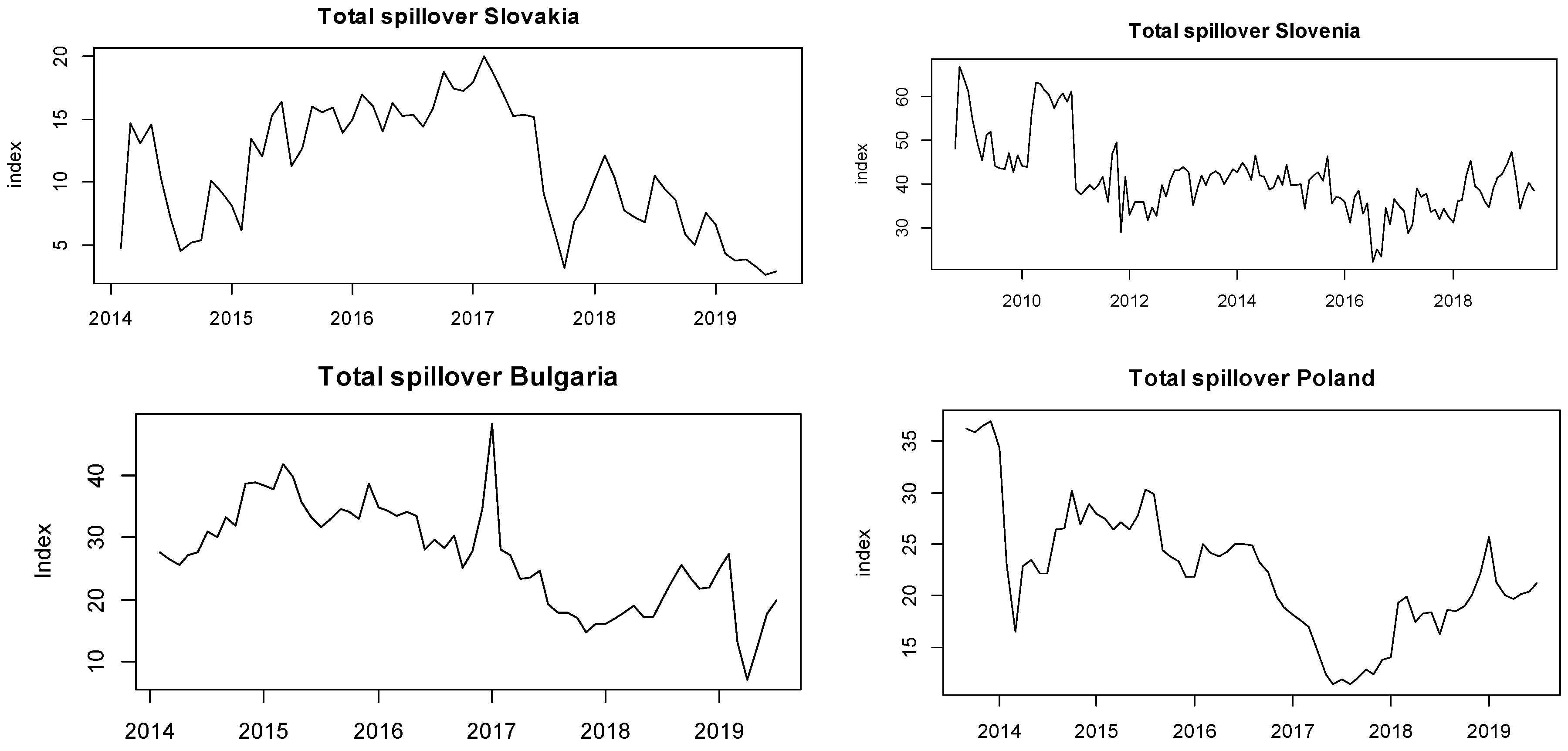
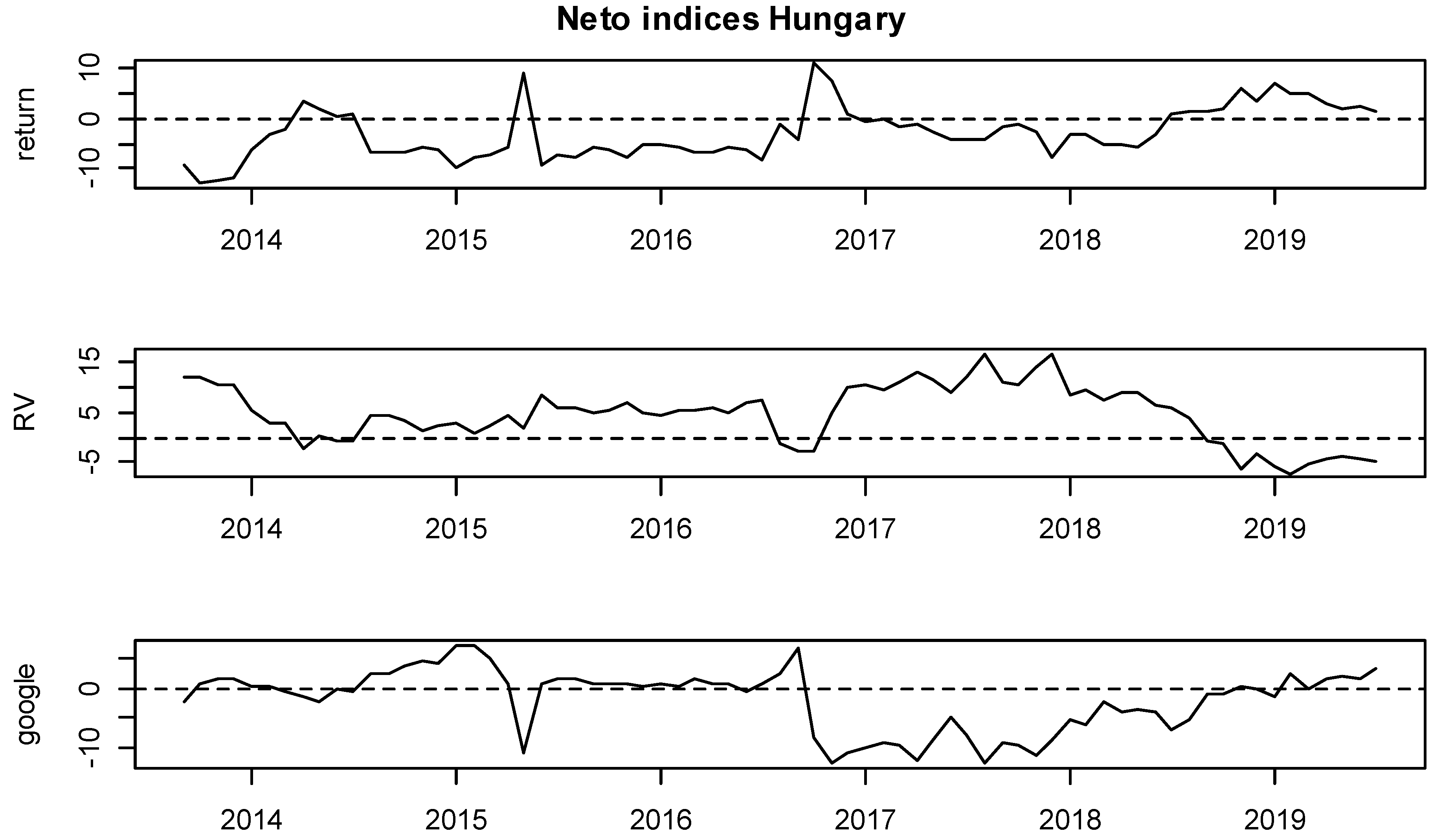
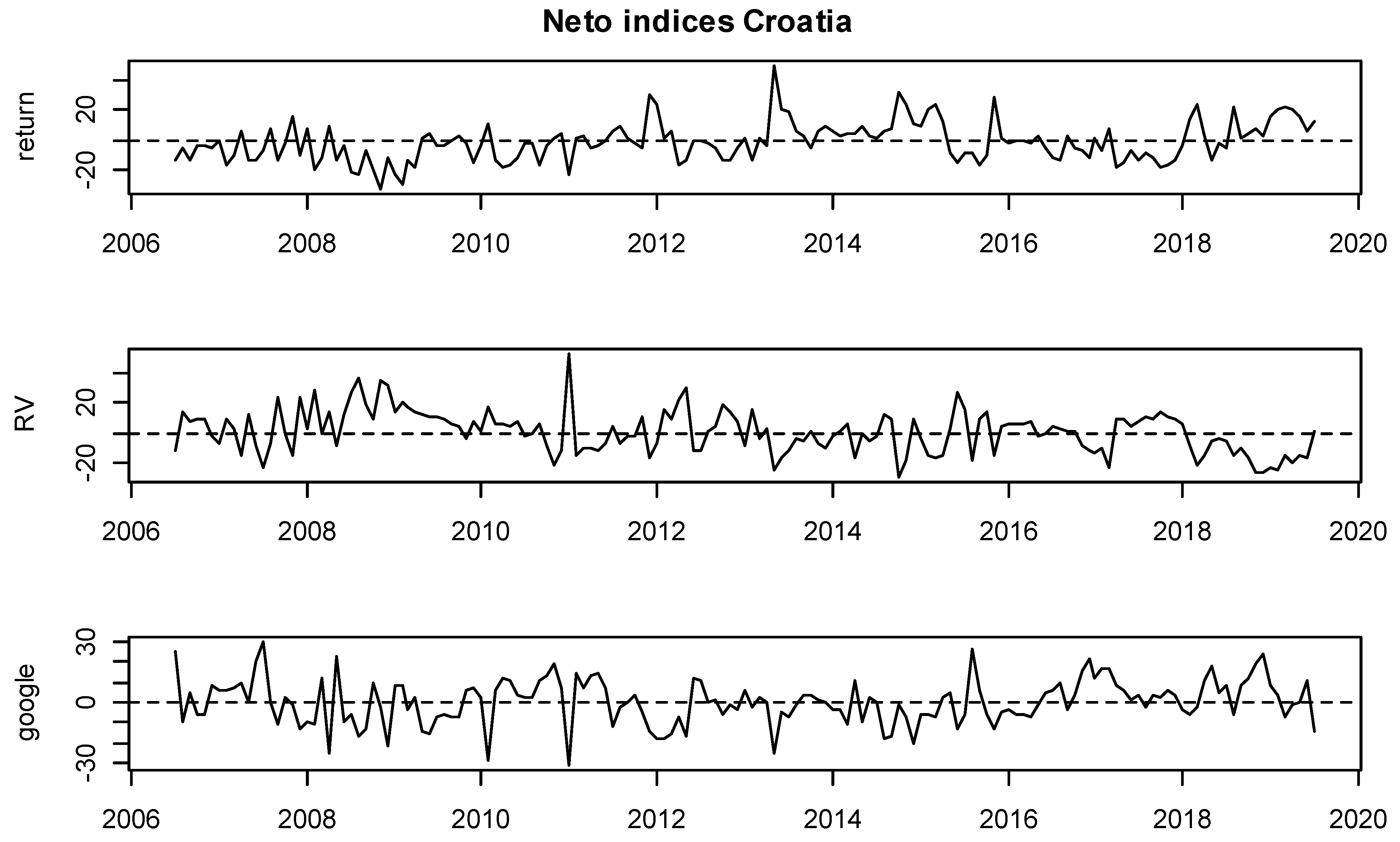
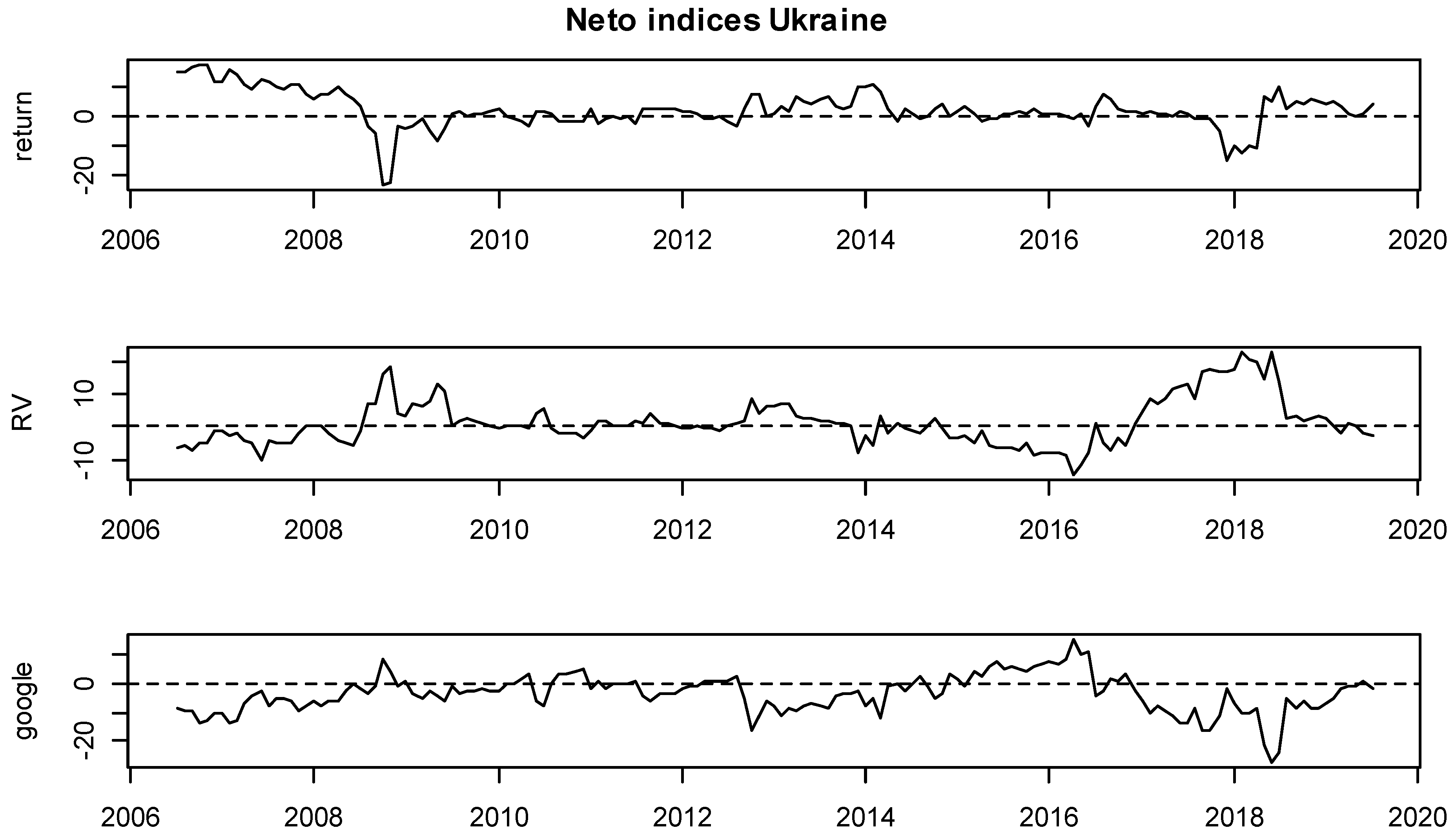


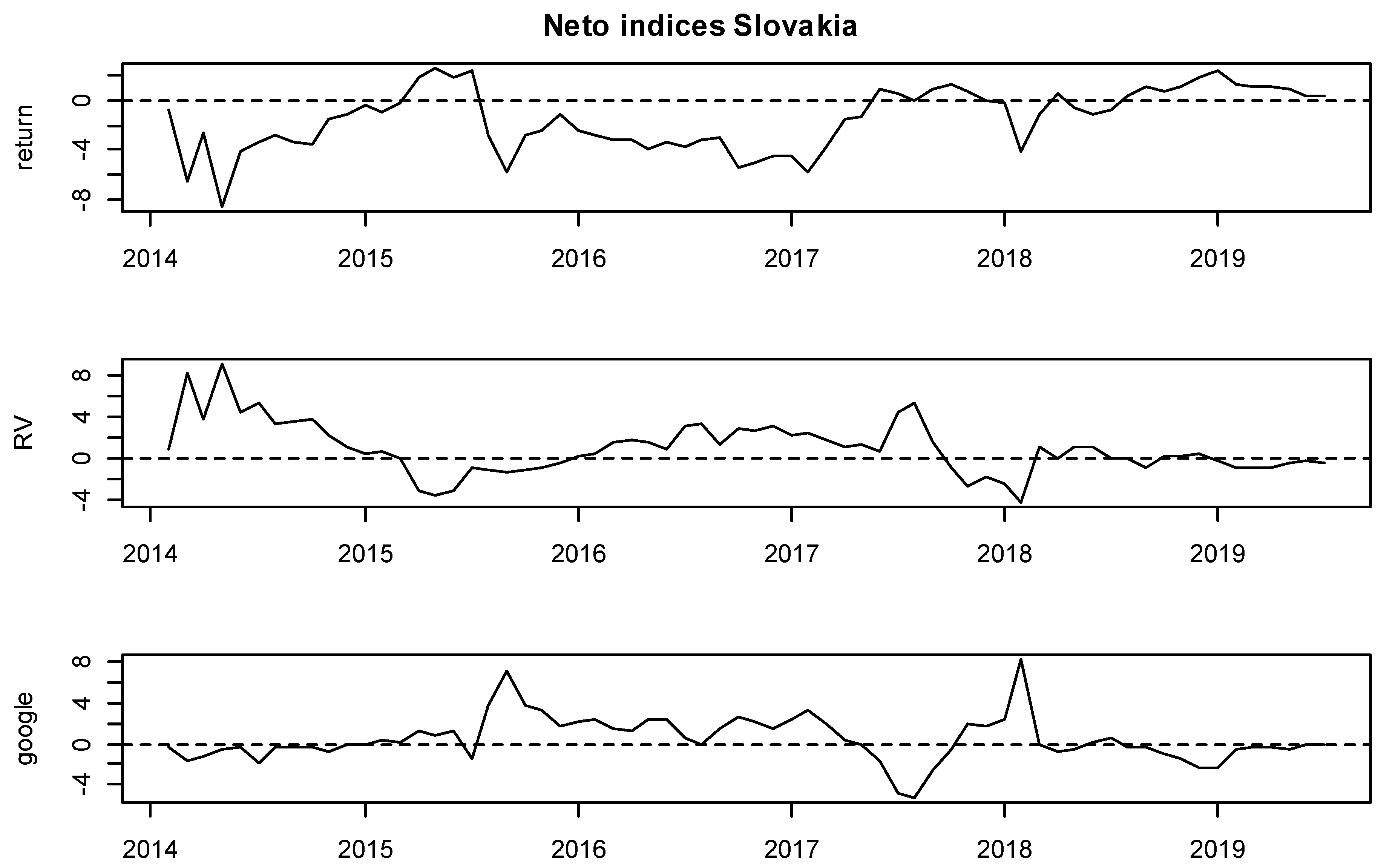
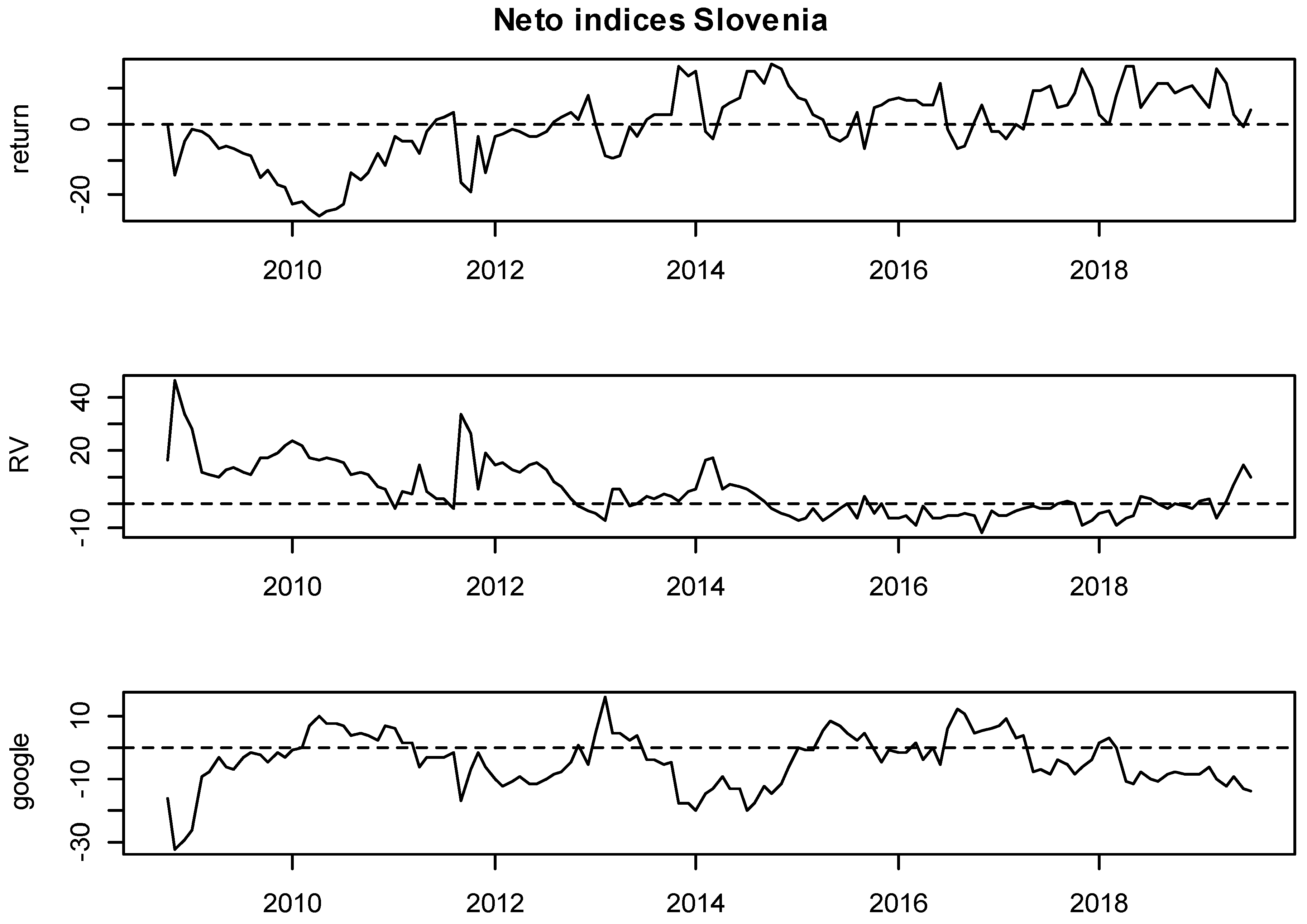

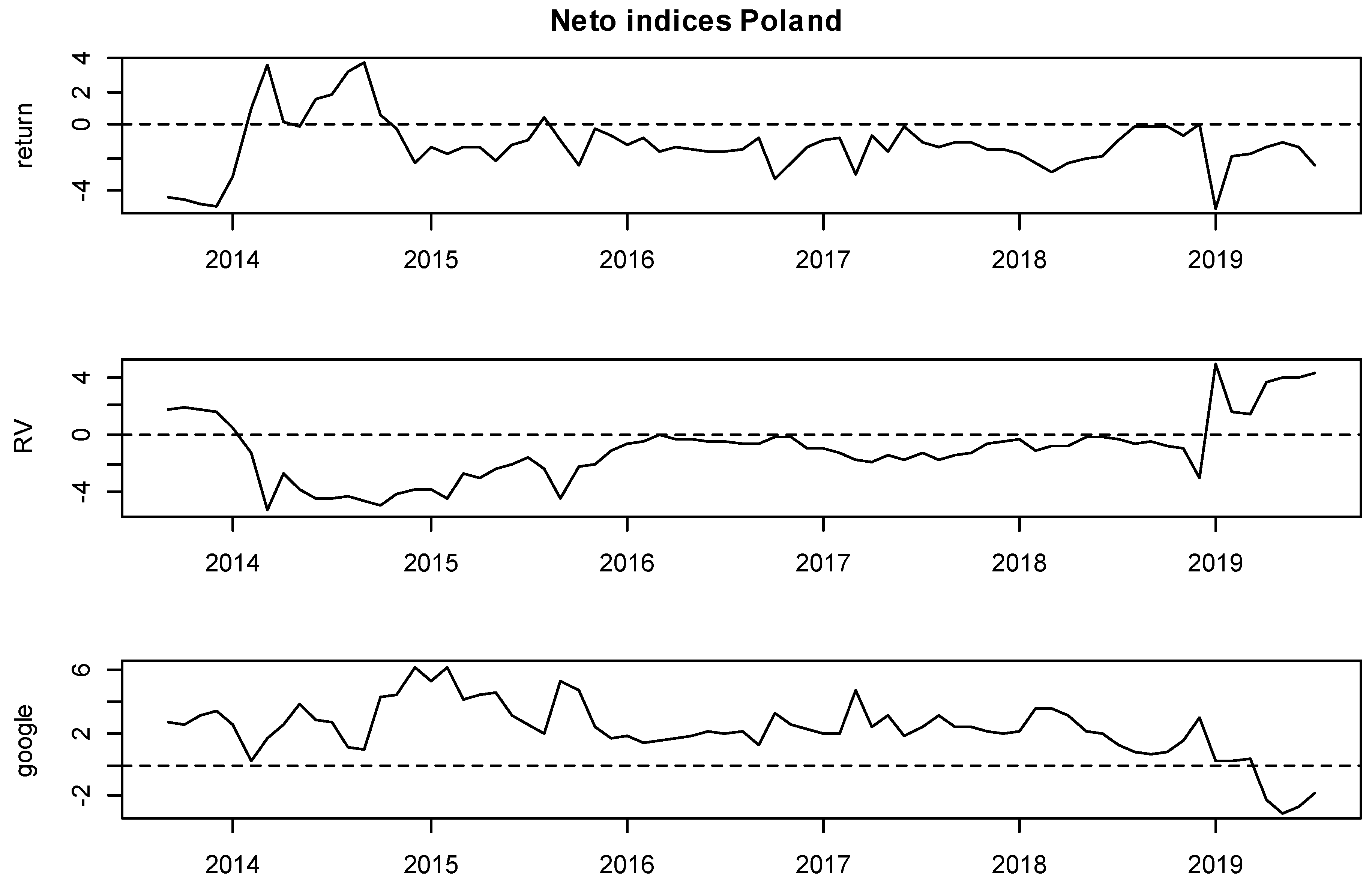
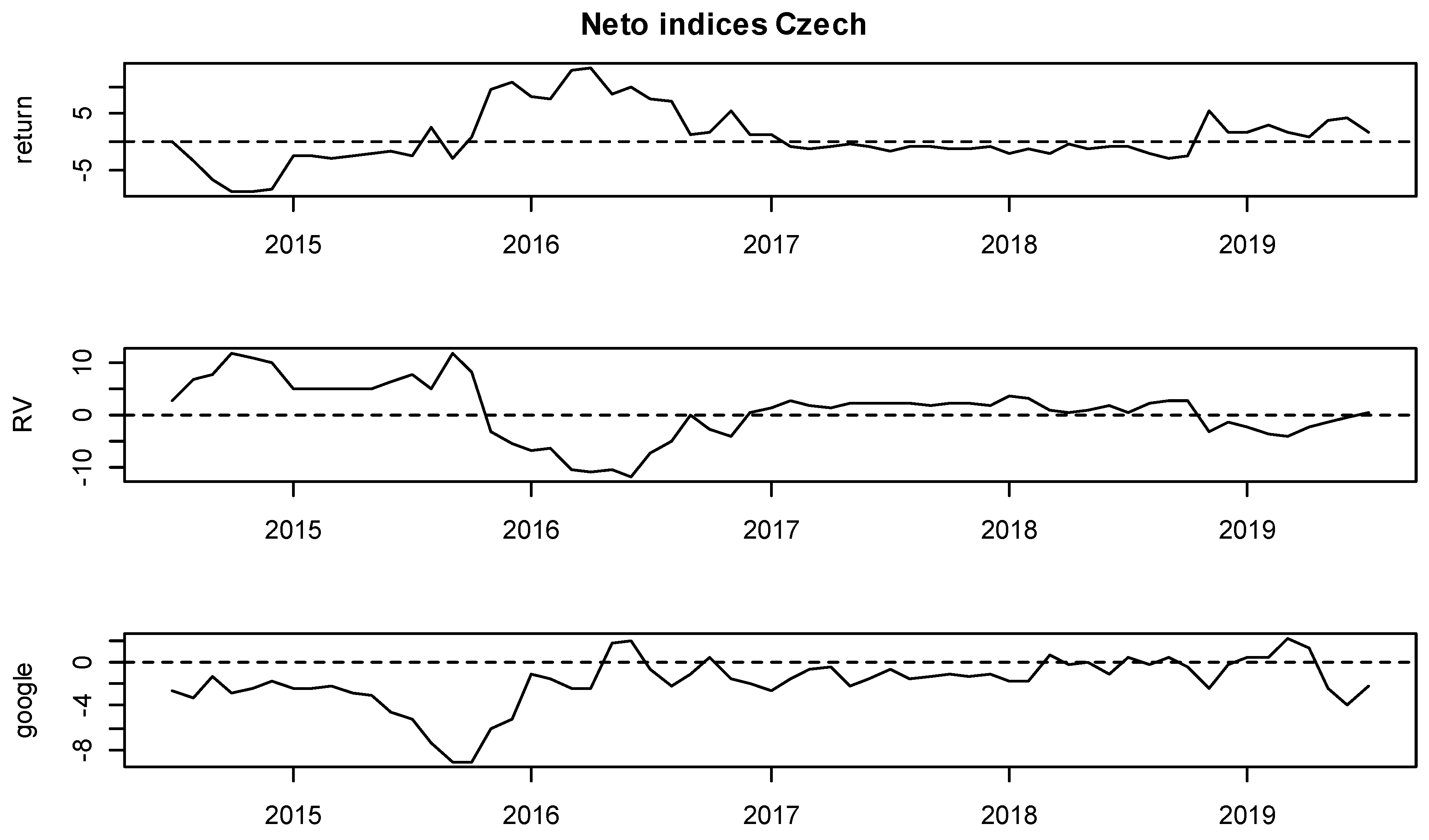
| Country | Initial Date | N | Index Name |
|---|---|---|---|
| Hungary | March 2011 | 100 | BUX |
| Croatia | January 2004 | 186 | CROBEX |
| Ukraine | January 2004 | 186 | PFTS |
| Slovenia | April 2006 | 159 | SBITOP |
| Poland | March 2011 | 100 | WIG |
| Bosnia and Herzegovina | December 2012 | 79 | BIRS |
| Czech Republic | January 2012 | 90 | PX |
| Slovakia | August 2011 | 95 | SAX |
| Bulgaria | August 2011 | 95 | SOFIX |
| Serbia | December 2012 | 79 | BELEX |
| Country | p (Length) |
|---|---|
| Hungary | 2 |
| Croatia | 6 |
| Ukraine | 3 |
| Slovenia | 4 |
| Poland | 1 |
| Bosnia and Herzegovina | 1 |
| Czech Republic | 2 |
| Slovakia | 1 |
| Bulgaria | 2 |
| Serbia | 1 |
| Country/Cause in the Granger Test | Excess Return | RV | GSV |
|---|---|---|---|
| Hungary | 1.148 (0.334) | 3.809 (0.005) *** | 2.169 (0.073) * |
| Croatia | 0.506 (0.911) | 3.808 (0.000) *** | 3.559 (0.000) *** |
| Ukraine | 1.393 (0.215) | 1.114 (0.341) | 1.111 (0.355) |
| Slovenia | 0.926 (0.495) | 6.881 (0.000) *** | 4.075 (0.000) *** |
| Poland | 0.027 (0.973) | 0.084 (0.919) | 0.517 (0.597) |
| Bosnia and Herzegovina | 2.607 (0.076) * | 0.374 (0.688) | 0.010 (0.989) |
| Czech Republic | 0.759 (0.553) | 0.709 (0.587) | 0.778 (0.540) |
| Slovakia | 0.403 (0.669) | 0.111 (0.895) | 0.410 (0.664) |
| Bulgaria | 1.590 (0.177) | 1.285 (0.276) | 3.175 (0.014) ** |
| Serbia | 0.454 (0.636) | 2.014 (0.136) | 2.655 (0.073) * |
| Excess Return | RV | GSV | From | |
|---|---|---|---|---|
| Excess Return | 95.34 | 2.30 | 2.36 | 1.55 |
| RV | 2.23 | 91.85 | 5.92 | 2.72 |
| GSV | 2.01 | 4.43 | 93.56 | 2.15 |
| TO | 1.41 | 2.24 | 2.76 | 6.42 |
| Excess Return | RV | GSV | From | |
|---|---|---|---|---|
| Excess Return | 91.45 | 7.23 | 1.32 | 2.85 |
| RV | 3.56 | 68.65 | 27.79 | 10.45 |
| GSV | 3.31 | 31.16 | 65.53 | 11.49 |
| TO | 2.29 | 12.80 | 9.70 | 24.79 |
| Excess Return | RV | GSV | From | |
|---|---|---|---|---|
| Excess Return | 70.55 | 16.03 | 13.42 | 9.82 |
| Std dev | 1.26 | 66.04 | 32.69 | 11.32 |
| GSV | 3.52 | 17.60 | 78.89 | 7.04 |
| TO | 1.59 | 11.21 | 15.37 | 28.17 |
| Excess Return | RV | GSV | From | |
|---|---|---|---|---|
| Excess Return | 98.28 | 1.48 | 0.24 | 0.57 |
| Std dev | 0.55 | 89.86 | 9.59 | 3.38 |
| GSV | 2.18 | 2.79 | 95.03 | 1.66 |
| TO | 0.91 | 1.42 | 3.28 | 5.61 |
| Excess Return | RV | GSV | From | |
|---|---|---|---|---|
| Excess Return | 98.41 | 1.36 | 0.23 | 0.53 |
| RV | 3.15 | 93.76 | 3.09 | 2.08 |
| GSV | 3.31 | 3.01 | 93.68 | 2.11 |
| TO | 2.15 | 1.46 | 1.11 | 4.72 |
| Excess Return | RV | GSV | From | |
|---|---|---|---|---|
| Excess Return | 98.17 | 1.36 | 0.47 | 0.61 |
| RV | 2.65 | 92.08 | 5.27 | 2.64 |
| GSV | 0.32 | 8.65 | 91.03 | 2.99 |
| TO | 0.99 | 3.34 | 1.91 | 6.24 |
| Excess Return | RV | GSV | From | |
|---|---|---|---|---|
| Excess Return | 96.28 | 0.63 | 3.09 | 1.24 |
| RV | 1.48 | 97.22 | 1.30 | 0.93 |
| GSV | 2.82 | 0.79 | 96.93 | 1.20 |
| TO | 1.43 | 0.47 | 1.46 | 3.37 |
| Excess Return | RV | GSV | From | |
|---|---|---|---|---|
| Excess Return | 74.92 | 17.19 | 7.89 | 8.36 |
| RV | 3.39 | 79.74 | 16.33 | 6.75 |
| GSV | 11.03 | 6.86 | 82.11 | 5.96 |
| TO | 4.99 | 8.02 | 8.07 | 21.07 |
| Excess Return | RV | GSV | From | |
|---|---|---|---|---|
| Excess Return | 99.17 | 0.11 | 0.72 | 0.28 |
| RV | 3.70 | 80.04 | 26.26 | 6.65 |
| GSV | 3.13 | 4.78 | 92.09 | 2.64 |
| TO | 2.28 | 1.63 | 5.66 | 9.57 |
| Excess Return | RV | GSV | From | |
|---|---|---|---|---|
| Excess Return | 97.86 | 0.83 | 1.31 | 0.71 |
| RV | 0.24 | 61.54 | 38.22 | 12.82 |
| GSV | 0.11 | 36.87 | 63.02 | 12.33 |
| TO | 0.12 | 12.57 | 13.17 | 25.86 |
© 2019 by the author. Licensee MDPI, Basel, Switzerland. This article is an open access article distributed under the terms and conditions of the Creative Commons Attribution (CC BY) license (http://creativecommons.org/licenses/by/4.0/).
Share and Cite
Škrinjarić, T. Time Varying Spillovers between the Online Search Volume and Stock Returns: Case of CESEE Markets. Int. J. Financial Stud. 2019, 7, 59. https://doi.org/10.3390/ijfs7040059
Škrinjarić T. Time Varying Spillovers between the Online Search Volume and Stock Returns: Case of CESEE Markets. International Journal of Financial Studies. 2019; 7(4):59. https://doi.org/10.3390/ijfs7040059
Chicago/Turabian StyleŠkrinjarić, Tihana. 2019. "Time Varying Spillovers between the Online Search Volume and Stock Returns: Case of CESEE Markets" International Journal of Financial Studies 7, no. 4: 59. https://doi.org/10.3390/ijfs7040059
APA StyleŠkrinjarić, T. (2019). Time Varying Spillovers between the Online Search Volume and Stock Returns: Case of CESEE Markets. International Journal of Financial Studies, 7(4), 59. https://doi.org/10.3390/ijfs7040059





